The Arabidopsis Transcription Factor MYB12
- 格式:pdf
- 大小:331.41 KB
- 文档页数:14
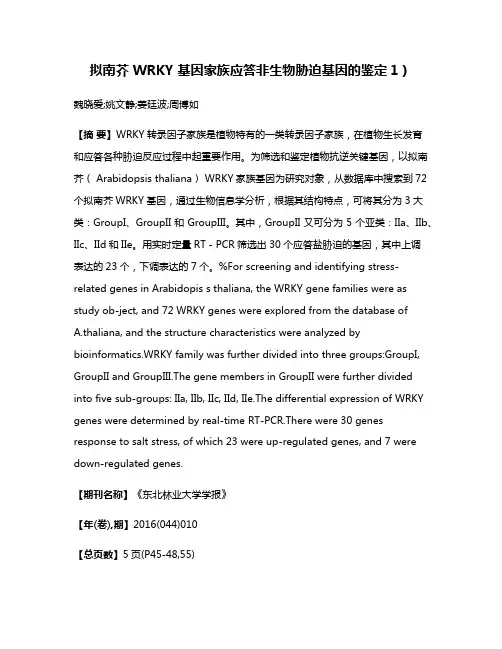
拟南芥 WRKY 基因家族应答非生物胁迫基因的鉴定1)魏晓爱;姚文静;姜廷波;周博如【摘要】WRKY转录因子家族是植物特有的一类转录因子家族,在植物生长发育和应答各种胁迫反应过程中起重要作用。
为筛选和鉴定植物抗逆关键基因,以拟南芥( Arabidopsis thaliana) WRKY家族基因为研究对象,从数据库中搜索到72个拟南芥WRKY基因,通过生物信息学分析,根据其结构特点,可将其分为3大类:GroupI、GroupII和GroupIII。
其中,GroupII又可分为5个亚类:IIa、IIb、IIc、IId和IIe。
用实时定量RT-PCR筛选出30个应答盐胁迫的基因,其中上调表达的23个,下调表达的7个。
%For screening and identifying stress-related genes in Arabidopis s thaliana, the WRKY gene families were as study ob-ject, and 72 WRKY genes were explored from the database ofA.thaliana, and the structure characteristics were analyzed by bioinformatics.WRKY family was further divided into three groups:GroupI, GroupII and GroupIII.The gene members in GroupII were further divided into five sub-groups: IIa, IIb, IIc, IId, IIe.The differential expression of WRKY genes were determined by real-time RT-PCR.There were 30 genes response to salt stress, of which 23 were up-regulated genes, and 7 were down-regulated genes.【期刊名称】《东北林业大学学报》【年(卷),期】2016(044)010【总页数】5页(P45-48,55)【关键词】拟南芥;WRKY转录因子;非生物胁迫【作者】魏晓爱;姚文静;姜廷波;周博如【作者单位】林木遗传育种国家重点实验室东北林业大学,哈尔滨,150040;林木遗传育种国家重点实验室东北林业大学,哈尔滨,150040;林木遗传育种国家重点实验室东北林业大学,哈尔滨,150040;林木遗传育种国家重点实验室东北林业大学,哈尔滨,150040【正文语种】中文【中图分类】Q78;S332.1WRKY转录因子是植物所特有的一类转录因子[1],1994年Ishiguro et al[2]从甘薯中克隆得到第一个WRKY转录因子SPF1,随后相继在野燕麦、拟南芥、烟草(Nicotiana tabacum L.)和水稻(Oryza sativa L.)中克隆得到WRKY。
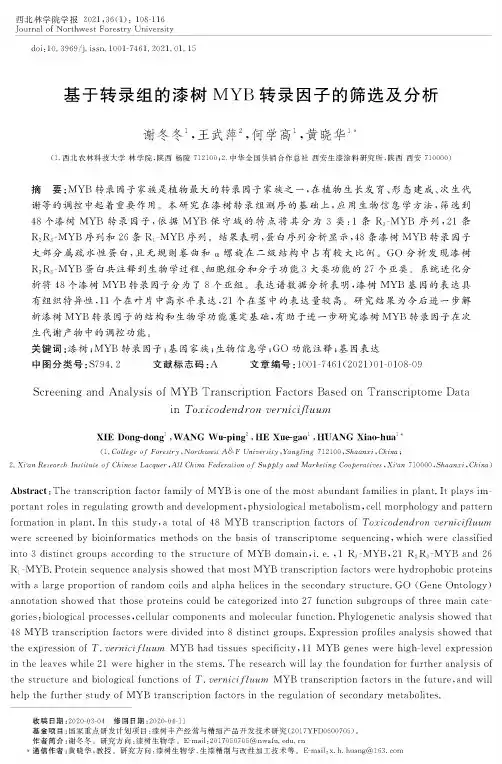
西北林学院学报2021,36(1):108116Journal of Northwest Forestry Universitydoi:10.3969/j.issn.1001-7461.2021.01.15基于转录组的漆树MYB转录因子的筛选及分析谢冬冬】,王武萍2,何学高】,黄晓华1*(1.西北农林科技大学林学院,陕西杨陵712100;.中华全国供销合作总社西安生漆涂料研究所,陕西西安710000)摘要:MYB转录因子家族是植物最大的转录因子家族之一,在植物生长发育、形态建成、次生代谢等的调控中起着重要作用。
本研究在漆树转录组测序的基础上,应用生物信息学方法,筛选到48个漆树MYB转录因子,依据MYB保守域的特点将其分为3类:1条R-MYB序列,21条R2R3-MYB序列和26条R]-MYB序列。
结果表明,蛋白序列分析显示,48条漆树MYB转录因子大部分属疏水性蛋白,且无规则卷曲和a螺旋在二级结构中占有较大比例。
GO分析发现漆树R2R-MYB蛋白共注释到生物学过程、细胞组分和分子功能3大类功能的27个亚类。
系统进化分析将48个漆树MYB转录因子分为了8个亚组。
表达谱数据分析表明,漆树MYB基因的表达具有组织特异性,11个在叶片中高水平表达,21个在茎中的表达量较高。
研究结果为今后进一步解析漆树MYB转录因子的结构和生物学功能奠定基础,有助于进一步研究漆树MYB转录因子在次生代谢产物中的调控功能。
关键词:漆树;MYB转录因子;基因家族;生物信息学;GO功能注释;基因表达中图分类号:S794.2文献标志码:A文章编号10017461(021)01010809Screening and Analysis of MYB Transcription Factors Based on Transcriptome Datain Toxicodendron vernicfluumXIE Dong-dong1,WANG Wu-ping2,HE Xuegao1,HUANG Xiao-hua1*(1.College of Forestry,Northwest A&-F University犢angling712100^Shaanxi,China;2.Xian Research Instituts of Chinese Lacquer All China Federabion of Supply and'Marketing CooperaLiuss^Xi7an710000, Shaanxi,China/Abstract:The transcription factor family of MYB is one of the most abundant families in plant.It plays im-portantrolesinregulatinggrowthanddevelopment,physiologicalmetabolism,ce l morphologyandpa t ern formation in plant.In this study,a total of48MYB transcription factors of Toxicodendron vemicifluum were screened by bioinformatics methods on the basis of transcriptome sequencing,which were classified into3distinct groups according to the structure of MYB domain,,e.,1R?-MYB,21R2R3-MYB and26 R1-MYB.Protein sequence analysis showed that most MYB transcription factors were hydrophobic proteins withalargeproportionofrandomcoilsandalphahelicesinthesecondarystructure GO(GeneOntology) annotation showed that those proteins could be categorized into27function subgroups of three main categories:biological processes,cellular components and molecular function.Phylogenetic analysis showed that 48MYBtranscriptionfactorsweredividedinto8distinctgroups Expressionprofilesanalysisshowedthat the expression of T.vemicifluum MYB had tissues specificity,11MYB genes were high-level expression in the leaves while21were higher in the stems.The research wi ll lay the foundation for further analysis of thestructureandbiologicalfunctionsof T vernicifluum MYBtranscriptionfactorsinthefuture,andwi l helpthefurtherstudyofMYBtranscriptionfactorsintheregulationofsecondary metabolites收稿日期:2020-03-04修回日期:2020-04-11基金项目:国家重点研发计划项目:漆树丰产经营与精细产品开发技术研究(017YFD0600705)作者简介:谢冬冬。
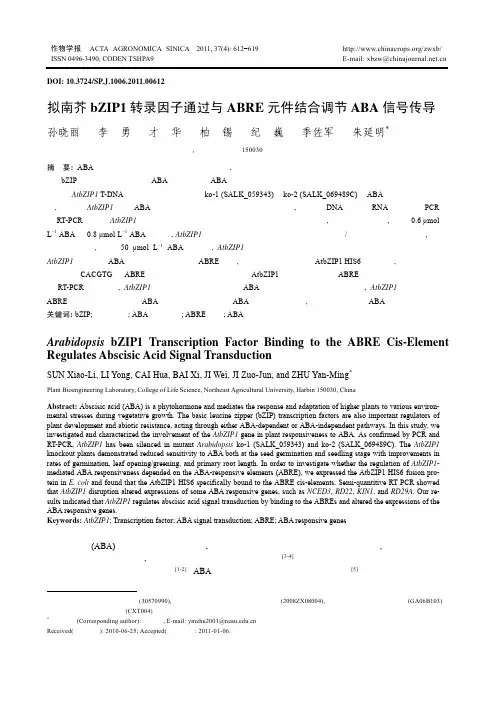
作物学报 ACTA AGRONOMICA SINICA 2011, 37(4): 612 619/zwxb/ISSN 0496-3490; CODEN TSHPA9E-mail: xbzw@本研究由国家自然科学基金项目(30570990), 国家转基因生物新品种培育重大专项(2008ZX08004), 黑龙江省重大科技攻关项目(GA06B103)和东北农业大学创新团队项目(CXT004)资助。
*通讯作者(Corresponding author): 朱延明, E-mail: ymzhu2001@Received(收稿日期): 2010-06-25; Accepted(接受日期): 2011-01-06.DOI: 10.3724/SP.J.1006.2011.00612拟南芥bZIP1转录因子通过与ABRE 元件结合调节ABA 信号传导孙晓丽 李 勇 才 华 柏 锡 纪 巍 季佐军 朱延明*东北农业大学生命科学学院植物生物工程研究室, 黑龙江哈尔滨150030摘 要: ABA 作为一种重要的植物激素和生长调节剂, 介导了高等植物在营养生长阶段对各种外界环境的响应和适应。
bZIP 类转录因子可以通过ABA 依赖途径和ABA 非依赖途径调节植物的生长发育和对非生物胁迫的耐性。
本研究通过AtbZIP1 T-DNA 插入突变的拟南芥植株ko-1 (SALK_059343)和ko-2 (SALK_069489C)在ABA 处理后的表型实验, 验证了AtbZIP1参与ABA 依赖的信号传导通路。
采用“三引物法”, 分别在DNA 水平和RNA 水平通过PCR 和RT-PCR 验证了AtbZIP1基因在拟南芥突变体中的沉默效果。
定量分析数据表明, 在种子萌发阶段, 经过0.6 μmol L –1 ABA 和0.8 μmol L –1 ABA 处理后, AtbZIP1缺失突变体拟南芥植株萌发率和叶片展开/绿色率比野生型植株高, 在幼苗生长阶段, 经过50 μmol L –1 ABA 处理后, AtbZIP1缺失突变体拟南芥植株根长比野生型植株长。
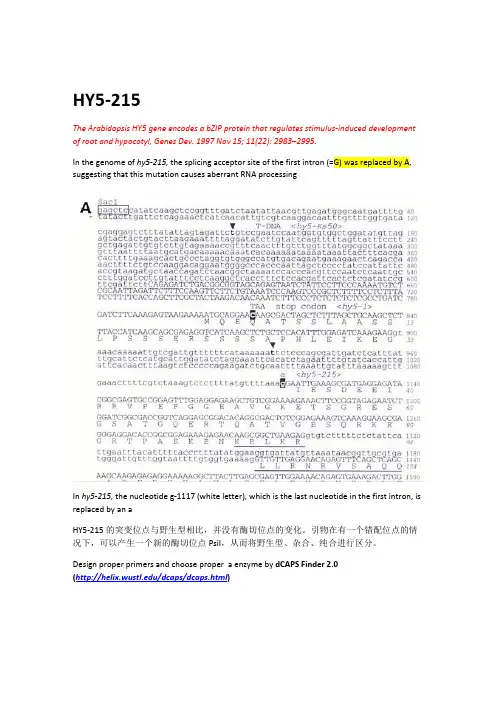
HY5‐215The Arabidopsis HY5 gene encodes a bZIP protein that regulates stimulus‐induced development of root and hypocotyl, Genes Dev. 1997 Nov 15; 11(22): 2983–2995.In the genome of hy5‐215, the splicing acceptor site of the first intron (=G) was replaced by A, suggesting that this mutation causes aberrant RNA processingIn hy5‐215, the nucleotide g‐1117 (white letter), which is the last nucleotide in the first intron, is replaced by an aHY5‐215的突变位点与野生型相比,并没有酶切位点的变化。
引物在有一个错配位点的情况下,可以产生一个新的酶切位点PsiI,从而将野生型、杂合、纯合进行区分。
Design proper primers and choose proper a enzyme by dCAPS Finder 2.0(/dcaps/dcaps.html)HY5proF GAGAGAATATGCGAGTGAATGAC Len 22 TM 54 HY5proR TCTAAAGTCTCTTTTATGTTTTA T A Len 25 TM 50.8PsiI:但是,实验室并没有PsiI ,所以只能再去寻找新的内切酶。
在设计的引物有2个错配位点时,可以产生新的酶切位点,AluI 将野生型切断。
HY5-215 F CGTATCTCCTCATCGCTTTCAATAG Len 25 TM 60.0 HY5-215 R GTCCCGCTCTTTTCCTCTTTATC Len 23 TM 60.8AluI:MYCTThe Arabidopsis bHLH Transcription Factors MYC3 and MYC4 Are Targets of JAZ Repressors and Act Additively with MYC2 in the Activation of Jasmonate Responses, Plant Cell. 2011 Feb; 23(2): 701–715.MYC2Mutagen : T‐DNA insertionInsertion FlankingSequence:TAAAACCGCCGGAGAATCAGATCACTCCGATCTAGAAGCT(Length:40)根据T‐DNA PrimerDesign(/tdnaprimers.2.html)设计引物PRODUCT_SIZE 1186Myc2LP TGGTTTTTCTTGGTTTCGATG Len 21 TM 59.96Myc2RP CTCTAATCATTGCGTCCCAAC Len 21 TM 59.58LBb1.3 ATTTTGCCGATTTCGGAAC BP+RP_PRODUCT_SIZE 558‐858MYC3Mutagen : T‐DNA insertionmyc3 F AAGGTGGGTTGTTGAAATCTAATG Len 24 TM 58.3myc3 R GTTTTCTCCGACTTTCGTCATCA Len 23 TM 61T-DNA ATATTGACCATCATACTCATTGC Len 23 TM 55.2MYC4Mutagen : T‐DNA insertionmyc4 F TCTCTCACAACTTGATCCAGCTAA Len 24 TM 60.0myc4 R TAACCGATTACCATCTCAACCAA Len 23 TM 59.2T-DNA ATATTGACCATCATACTCATTGC Len 23 TM 55.2Phyb‐9Mutations in the gene for the red/far‐red light receptor phytochrome B alter cell elongation and physiological responses throughout Arabidopsis development. Plant Cell v.5(2); 1993 Febhy3-EMS742 is a G-toA mutationphyb9 F CTGTTCAATCGCAGAAACTCGCGGT Len25phyb9 R CCGTCACATTTCACTAAGTCCAT Len 23 TM58.6MnlI:但是,实验室并没有MnlI,所以只能再去寻找新的内切酶。
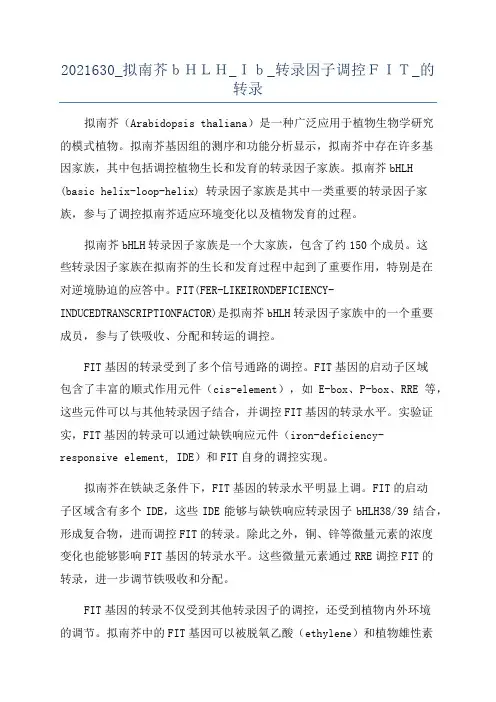
2021630_拟南芥bHLH_Ib_转录因子调控FIT_的转录拟南芥(Arabidopsis thaliana)是一种广泛应用于植物生物学研究的模式植物。
拟南芥基因组的测序和功能分析显示,拟南芥中存在许多基因家族,其中包括调控植物生长和发育的转录因子家族。
拟南芥bHLH (basic helix-loop-helix) 转录因子家族是其中一类重要的转录因子家族,参与了调控拟南芥适应环境变化以及植物发育的过程。
拟南芥bHLH转录因子家族是一个大家族,包含了约150个成员。
这些转录因子家族在拟南芥的生长和发育过程中起到了重要作用,特别是在对逆境胁迫的应答中。
FIT(FER-LIKEIRONDEFICIENCY-INDUCEDTRANSCRIPTIONFACTOR)是拟南芥bHLH转录因子家族中的一个重要成员,参与了铁吸收、分配和转运的调控。
FIT基因的转录受到了多个信号通路的调控。
FIT基因的启动子区域包含了丰富的顺式作用元件(cis-element),如E-box、P-box、RRE等,这些元件可以与其他转录因子结合,并调控FIT基因的转录水平。
实验证实,FIT基因的转录可以通过缺铁响应元件(iron-deficiency-responsive element, IDE)和FIT自身的调控实现。
拟南芥在铁缺乏条件下,FIT基因的转录水平明显上调。
FIT的启动子区域含有多个IDE,这些IDE能够与缺铁响应转录因子bHLH38/39结合,形成复合物,进而调控FIT的转录。
除此之外,铜、锌等微量元素的浓度变化也能够影响FIT基因的转录水平。
这些微量元素通过RRE调控FIT的转录,进一步调节铁吸收和分配。
FIT基因的转录不仅受到其他转录因子的调控,还受到植物内外环境的调节。
拟南芥中的FIT基因可以被脱氧乙酸(ethylene)和植物雄性素(gibberellin)等植物内源激素调控,进而影响铁离子的吸收和分配。
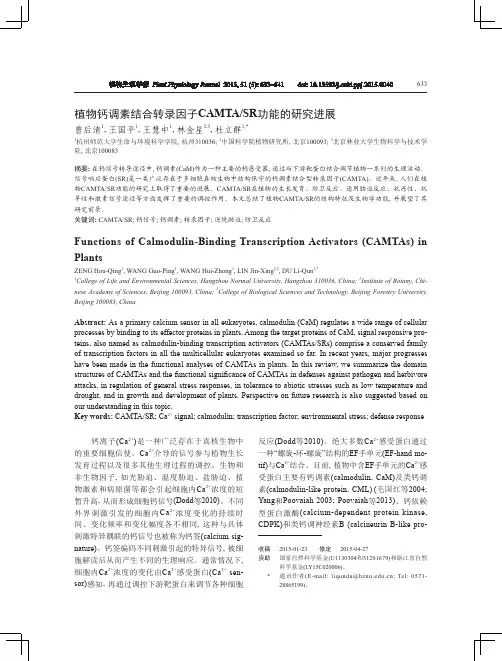
植物生理学报 Plant Physiology Journal 2015, 51 (5): 633~641 doi: 10.13592/ki.ppj.2015.0040633收稿 2015-01-23 修定 2015-04-27资助 国家自然科学基金(U1130304和31201679)和浙江省自然科学基金(LY15C020006)。
* 通讯作者(E-mail: liqundu@; Tel: 0571-********)。
植物钙调素结合转录因子CAMTA/SR 功能的研究进展曾后清1, 王国平1, 王慧中1, 林金星2,3, 杜立群1,*1杭州师范大学生命与环境科学学院, 杭州310036; 2中国科学院植物研究所, 北京100093; 3北京林业大学生物科学与技术学院, 北京100083摘要: 在钙信号转导途径中, 钙调素(CaM)作为一种主要的钙感受器, 通过与下游靶蛋白结合调节植物一系列的生理活动。
信号响应蛋白(SR)是一类广泛存在于多细胞真核生物中结构保守的钙调素结合型转录因子(CAMTA)。
近年来, 人们在植物CAMTA/SR 功能的研究上取得了重要的进展。
CAMTA/SR 在植物的生长发育、防卫反应、通用胁迫反应、抗冻性、抗旱性和激素信号途径等方面发挥了重要的调控作用。
本文总结了植物CAMTA/SR 的结构特征及生物学功能, 并展望了其研究前景。
关键词: CAMTA/SR; 钙信号; 钙调素; 转录因子; 逆境胁迫; 防卫反应Functions of Calmodulin-Binding Transcription Activators (CAMTAs) in PlantsZENG Hou-Qing 1, WANG Guo-Ping 1, WANG Hui-Zhong 1, LIN Jin-Xing 2,3, DU Li-Qun 1,*1College of Life and Environmental Sciences, Hangzhou Normal University, Hangzhou 310036, China; 2Institute of Botany, Chi-nese Academy of Sciences, Beijing 100093, China; 3College of Biological Sciences and Technology, Beijing Forestry University, Beijing 100083, ChinaAbstract: As a primary calcium sensor in all eukaryotes, calmodulin (CaM) regulates a wide range of cellular processes by binding to its effector proteins in plants. Among the target proteins of CaM, signal responsive pro-teins, also named as calmodulin-binding transcription activators (CAMTAs/SRs) comprise a conserved family of transcription factors in all the multicellular eukaryotes examined so far. In recent years, major progresses have been made in the functional analyses of CAMTAs in plants. In this review, we summarize the domain structures of CAMTAs and the functional significance of CAMTAs in defenses against pathogen and herbivore attacks, in regulation of general stress responses, in tolerance to abiotic stresses such as low temperature and drought, and in growth and development of plants. Perspective on future research is also suggested based on our understanding in this topic.Key words: CAMTA/SR; Ca 2+ signal; calmodulin; transcription factor; environmental stress; defense response 钙离子(Ca 2+)是一种广泛存在于真核生物中的重要细胞信使。
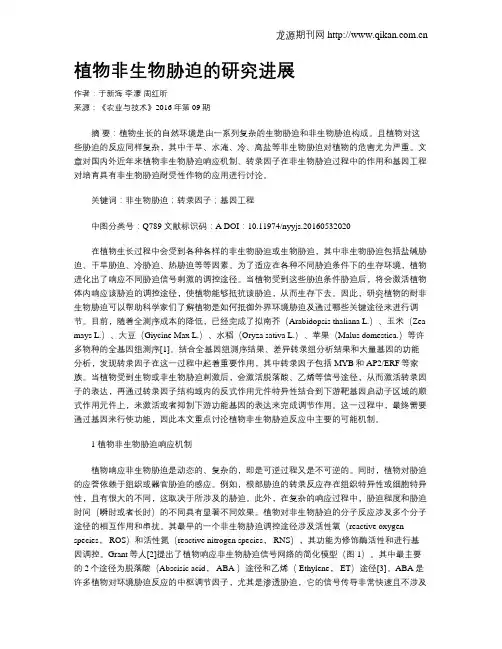
植物非生物胁迫的研究进展作者:于新海李濛周红昕来源:《农业与技术》2016年第09期摘要:植物生长的自然环境是由一系列复杂的生物胁迫和非生物胁迫构成。
且植物对这些胁迫的反应同样复杂,其中干旱、水淹、冷、高盐等非生物胁迫对植物的危害尤为严重。
文章对国内外近年来植物非生物胁迫响应机制、转录因子在非生物胁迫过程中的作用和基因工程对培育具有非生物胁迫耐受性作物的应用进行讨论。
关键词:非生物胁迫;转录因子;基因工程中图分类号:Q789 文献标识码:A DOI:10.11974/nyyjs.20160532020在植物生长过程中会受到各种各样的非生物胁迫或生物胁迫,其中非生物胁迫包括盐碱胁迫、干旱胁迫、冷胁迫、热胁迫等等因素。
为了适应在各种不同胁迫条件下的生存环境,植物进化出了响应不同胁迫信号刺激的调控途径。
当植物受到这些胁迫条件胁迫后,将会激活植物体内响应该胁迫的调控途径,使植物能够抵抗该胁迫,从而生存下去。
因此,研究植物的耐非生物胁迫可以帮助科学家们了解植物是如何抵御外界环境胁迫及通过哪些关键途径来进行调节。
目前,随着全测序成本的降低,已经完成了拟南芥(Arabidopsis thaliana L.)、玉米(Zea mays L.)、大豆(Giycine Max L.)、水稻(Oryza sativa L.)、苹果(Malus domestica.)等许多物种的全基因组测序[1]。
结合全基因组测序结果、差异转录组分析结果和大量基因的功能分析,发现转录因子在这一过程中起着重要作用,其中转录因子包括MYB和AP2/ERF等家族。
当植物受到生物或非生物胁迫刺激后,会激活脱落酸、乙烯等信号途径,从而激活转录因子的表达,再通过转录因子结构域内的反式作用元件特异性结合到下游靶基因启动子区域的顺式作用元件上,来激活或者抑制下游功能基因的表达来完成调节作用。
这一过程中,最终需要通过基因来行使功能,因此本文重点讨论植物非生物胁迫反应中主要的可能机制。
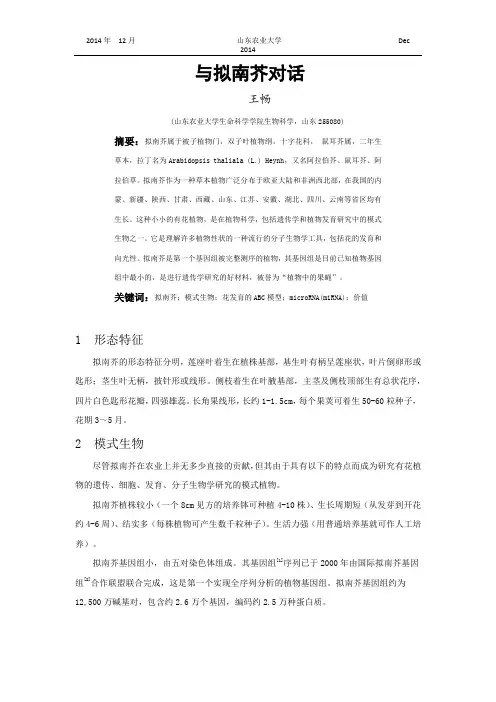
与拟南芥对话王畅(山东农业大学生命科学学院生物科学,山东255080)摘要:拟南芥属于被子植物门,双子叶植物纲,十字花科,鼠耳芥属,二年生草本,拉丁名为Arabidopsis thaliala (L.) Heynh,又名阿拉伯芥、鼠耳芥、阿拉伯草。
拟南芥作为一种草本植物广泛分布于欧亚大陆和非洲西北部,在我国的内蒙、新疆、陕西、甘肃、西藏、山东、江苏、安徽、湖北、四川、云南等省区均有生长。
这种小小的有花植物,是在植物科学,包括遗传学和植物发育研究中的模式生物之一。
它是理解许多植物性状的一种流行的分子生物学工具,包括花的发育和向光性。
拟南芥是第一个基因组被完整测序的植物,其基因组是目前已知植物基因组中最小的,是进行遗传学研究的好材料,被誉为“植物中的果蝇”。
关键词:拟南芥;模式生物;花发育的ABC模型;microRNA(miRNA);价值1 形态特征拟南芥的形态特征分明,莲座叶着生在植株基部,基生叶有柄呈莲座状,叶片倒卵形或匙形;茎生叶无柄,披针形或线形。
侧枝着生在叶腋基部,主茎及侧枝顶部生有总状花序,四片白色匙形花瓣,四强雄蕊。
长角果线形,长约1-1.5cm,每个果荚可着生50-60粒种子,花期3~5月。
2 模式生物尽管拟南芥在农业上并无多少直接的贡献,但其由于具有以下的特点而成为研究有花植物的遗传、细胞、发育、分子生物学研究的模式植物。
拟南芥植株较小(一个8cm见方的培养钵可种植4-10株)、生长周期短(从发芽到开花约4-6周)、结实多(每株植物可产生数千粒种子)。
生活力强(用普通培养基就可作人工培养)。
拟南芥基因组小,由五对染色体组成。
其基因组[1]序列已于2000年由国际拟南芥基因组[2]合作联盟联合完成,这是第一个实现全序列分析的植物基因组。
拟南芥基因组约为12,500万碱基对,包含约2.6万个基因,编码约2.5万种蛋白质。
拟南芥是典型的自花受粉植物,基因高度纯合,易于保持遗传稳定性,通过物理(如辐射处理)、化学(如EMS诱变)及生物(如利用植物内源转座子或者根瘤农杆菌将DNA片段转入拟南芥基因组)的手段,已获得大量的发生在不同基因位点的突变体,易获得各种代谢功能的缺陷型。
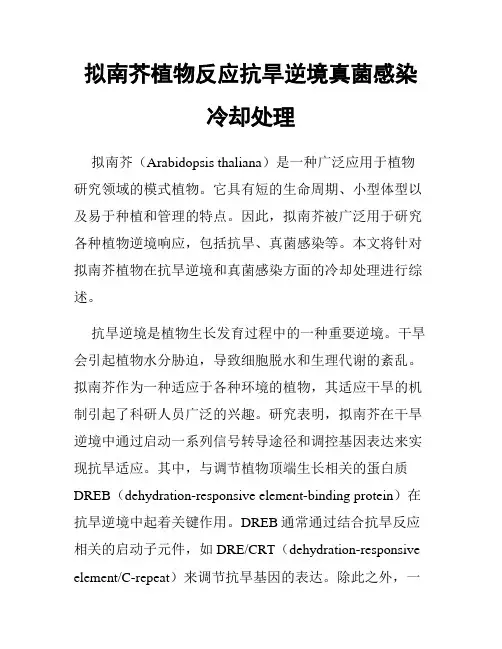
拟南芥植物反应抗旱逆境真菌感染冷却处理拟南芥(Arabidopsis thaliana)是一种广泛应用于植物研究领域的模式植物。
它具有短的生命周期、小型体型以及易于种植和管理的特点。
因此,拟南芥被广泛用于研究各种植物逆境响应,包括抗旱、真菌感染等。
本文将针对拟南芥植物在抗旱逆境和真菌感染方面的冷却处理进行综述。
抗旱逆境是植物生长发育过程中的一种重要逆境。
干旱会引起植物水分胁迫,导致细胞脱水和生理代谢的紊乱。
拟南芥作为一种适应于各种环境的植物,其适应干旱的机制引起了科研人员广泛的兴趣。
研究表明,拟南芥在干旱逆境中通过启动一系列信号转导途径和调控基因表达来实现抗旱适应。
其中,与调节植物顶端生长相关的蛋白质DREB(dehydration-responsive element-binding protein)在抗旱逆境中起着关键作用。
DREB通常通过结合抗旱反应相关的启动子元件,如DRE/CRT(dehydration-responsive element/C-repeat)来调节抗旱基因的表达。
除此之外,一些拟南芥植物激素和信号分子也参与了抗旱逆境下的调节,如脱落酸、脱落酸反应基因及MYB转录因子等。
在面临真菌感染逆境时,拟南芥植物也会采取一系列防御机制来抵抗真菌感染。
拟南芥通过产生抗菌蛋白和调节关键防御基因表达来对抗真菌的侵袭。
例如,拟南芥可产生一种名为PR蛋白(pathogenesis-related proteins)的抗菌蛋白。
这些抗菌蛋白可以直接杀死真菌,或通过增强植物自身防御系统来抗击真菌感染。
此外,一些与拟南芥植物免疫反应相关的信号分子也在对抗真菌感染中发挥重要作用。
其中,植物激素茉莉酸和乙烯增加了拟南芥植物对抗真菌感染的抵抗力。
茉莉酸通过激活一系列抗真菌基因的表达来增强植物抗真菌能力,而乙烯则参与了拟南芥植物对真菌感染的信号传导过程。
冷却处理是一种常用的实验手段,用于模拟植物在低温环境中的逆境响应。
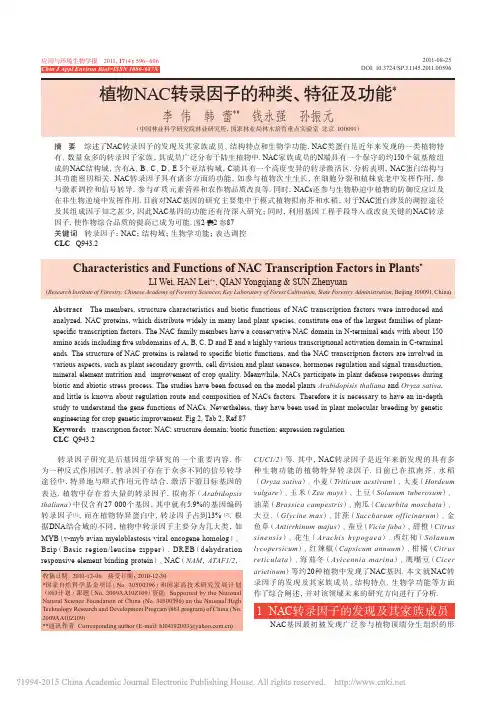
2011-08-25DOI: 10.3724/SP.J.1145.2011.00596应用与环境生物学报 2011,17 ( 4 ): 596~606转录因子研究是后基因组学研究的一个重要内容. 作为一种反式作用因子,转录因子存在于众多不同的信号转导途径中,特异地与顺式作用元件结合,激活下游目标基因的表达. 植物中存在着大量的转录因子,拟南芥(Arabidopsis thaliana )中仅含有27 000个基因,其中就有5.9%的基因编码转录因子[1],而在植物特异蛋白中,转录因子占到13% [2]. 根据DNA 结合域的不同,植物中转录因子主要分为几大类,如MYB (v-myb avian myeloblastosis viral oncogene homolog )、Bzip (Basic region/leucine zipper )、DREB (dehydration responsive element binding protein )、NAC (NAM ,ATAF1/2,CUC1/2)等. 其中,NAC 转录因子是近年来新发现的具有多种生物功能的植物特异转录因子. 目前已在拟南芥、水稻(Oryza sativa )、小麦(Triticum aestivum )、大麦(Hordeum vulgare )、玉米(Zea mays )、土豆(Solanum tuberosum )、油菜(Brassica campestris )、南瓜(Cucurbita moschata )、大豆、(Glycine max )、甘蔗(Saccharum officinarum )、金鱼草(Antirrhinum majus )、蚕豆(Vicia faba )、甜橙(Citrus sinensis )、花生(Arachis hypogaea )、西红柿(Solanum lycopersicum )、红辣椒(Capsicum annuum )、柑橘(Citrus reticulata )、海茄冬(Avicennia marina )、鹰嘴豆(Cicer arietinum )等约20种植物中发现了NAC 基因. 本文就NAC 转录因子的发现及其家族成员、结构特点、生物学功能等方面作了综合阐述,并对该领域未来的研究方向进行了分析.1 NAC 转录因子的发现及其家族成员NAC基因最初被发现广泛参与植物顶端分生组织的形Characteristics and Functions of NAC Transcription Factors in Plants *LI Wei, HAN Lei **, QIAN Yongqiang & SUN Zhenyuan(Research Institute of Forestry, Chinese Academy of Forestry Sciences ; Key Laboratory of Forest Cultivation, State Forestry Administration , Beijing 100091, China)Abstract The members, structure characteristics and biotic functions of NAC transcription factors were introduced and analyzed. NAC proteins, which distribute widely in many land plant species, constitute one of the largest families of plant-speci fi c transcription factors. The NAC family members have a conservative NAC domain in N-terminal ends with about 150 amino acids including fi ve subdomains of A, B, C, D and E and a highly various transcriptional activation domain in C-terminal ends. The structure of NAC proteins is related to speci fi c biotic functions, and the NAC transcription factors are involved in various aspects, such as plant secondary growth, cell division and plant senesce, hormones regulation and signal transduction, mineral element nutrition and improvement of crop quality. Meanwhile, NACs participate in plant defense responses during biotic and abiotic stress process. The studies have been focused on the model plants Arabidopisis thaliana and Oryza sativa , and little is known about regulation route and composition of NACs factors. Therefore it is necessary to have an in-depth study to understand the gene functions of NACs. Nevertheless, they have been used in plant molecular breeding by genetic engineering for crop genetic improvement. Fig 2, Tab 2, Ref 87Keywords transcription factor; NAC; structure domain; biotic function; expression regulation CLC Q943.2摘 要 综述了NAC 转录因子的发现及其家族成员、结构特点和生物学功能. NAC 类蛋白是近年来发现的一类植物特有、数量众多的转录因子家族,其成员广泛分布于陆生植物中. NAC 家族成员的N 端具有一个保守的约150个氨基酸组成的NAC 结构域,含有A 、B 、C 、D 、E 5个亚结构域,C 端具有一个高度变异的转录激活区. 分析表明,NAC 蛋白结构与其功能密切相关. NAC 转录因子具有诸多方面的功能,如参与植物次生生长,在细胞分裂和植株衰老中发挥作用,参与激素调控和信号转导,参与矿质元素营养和农作物品质改良等. 同时,NACs 还参与生物胁迫中植物的防御反应以及在非生物逆境中发挥作用. 目前对NAC 基因的研究主要集中于模式植物拟南芥和水稻,对于NAC 蛋白涉及的调控途径及其组成因子知之甚少,因此NAC 基因的功能还有待深入研究;同时,利用基因工程手段导入或改良关键的NAC 转录因子,使作物综合品质的提高已成为可能. 图2 表2 参87关键词 转录因子;NAC ;结构域;生物学功能;表达调控CLC Q943.2597 4 期李 伟等:植物NAC转录因子的种类、特征及功能成和器官边界的建立. 1996年,Souer等从矮牵牛中克隆到第一个NAC基因NAM(no apical meristem),其nam突变体的幼胚缺失根尖分生组织、幼苗缺失根和叶[3]. 随后,Aida 等在拟南芥中发现了具有类似功能的CUC2(cup2 shaped cotyledon),cuc2突变体不能形成正常的顶端分生组织,突变体子叶融合呈杯状,萼片与雄蕊融合[4]. NAM和CUC2都属于NAM亚族,同属于该亚家族的,还有水稻的ONAC300、金鱼草的CUP和南瓜的CmNACP [5]. Vroemen等从拟南芥中分离到与CUC1和CUC2同源的CUC3. 通过对CUC3的亚等位基因和cuc3缺失突变体分析显示,CUC1和CUC2在子叶边缘和茎顶端分生组织的形态建成中发挥功能,而此时CUC3存在功能性冗余[6]. 这些结果都表明CUC诱导器官边界的建成,同时促进茎尖分生组织的分化.Duval等从发育中的拟南芥种子cDNA文库中分离到一个NAC基因AtNAM. AtNAM主要在胚胎顶端分生组织以及中轴线与子叶之间表达,而含有顶端分生组织的胚胎AtNAM的表达受到抑制,暗示AtNAM参与分生组织的形成和器官边界的建立[7].2003年,Ooka等首次对水稻和拟南芥NAC家族蛋白进行了全面分析,根据水稻数据库和拟南芥基因组分别预测了75个和105个NAC蛋白,并根据预测和已知的NAC 结构域的序列相似性将其分为2个大组和18个亚组. 组Ⅰ包含TERN、ONAC022、SENU5、NAP、AtNAC3、ATAF、OsNAC3、NAC2、ANAC011、TIP、OsNAC8、OsNAC7、NAC1和NAM等14个成员;组Ⅱ包含4个成员ANAC001、ONAC003、ONAC001和ANAC063. 其中,ANAC011、AtNAC3、ANAC063和ANAC001这4个亚组完全由拟南芥NAC转录因子组成,而OsNAC3和ONAC001亚组则由单子叶植物水稻和小麦的NAC 转录因子组成[8]. 随后,对NAC亚家族成员的研究基本上都是以Ooka的分类为依据展开的.2NAC转录因子具有显著的结构特点,即蛋白的N端含有高度保守的约150个氨基酸组成的NAC结构域. NAC结构域不包含任何已知的蛋白结构域,而是以几个螺旋元件包围着一个扭曲的β–折叠片结构代替了典型的螺旋–转角–螺旋结构[9]. 例如拟南芥的ABA响应元件ANAC,其NAC结构域具有β–桶或β–三明治结构[10]. 同时,NAC结构域包含5个保守的亚结构域A、B、C、D、E,其中亚域C可能与结合DNA 有关,亚域E可能参与发育时期调控和(或)组织特异性,并协同亚域D与DNA发生相互作用[9, 11]. NAC蛋白C–端高度多样化,是转录激活区,该区域具有共同的特点,即频繁出现简单氨基酸的重复序列,如丝氨酸、苏氨酸、脯氨酸和谷氨酸,或酸性残基,这是植物转录激活区域的共同特征. 对拟南芥基因组分析发现,至少13个拟南芥NAC蛋白具有跨膜功能,在他们C-端包含α-螺旋跨膜序列(TMs). 并且很多假定的NAC-MTFs基因在胁迫下上调,表明他们可能参与胁迫响应[12]. 尽管如此,Ooka等仍从预测的NAC蛋白的C-端发现了13个共同序列,这些序列分别存在于12个NAC亚组[8].大多数的NAC蛋白都能形成同源或异源二聚体,这可能是它们结合DNA的基本形式[13]. 此外,NAC蛋白还会与其它蛋白发生互作,ANAC019、ANAC055以及ANAC072能在体外或者体内特异地与CATGTG序列结合,并激活报告基因GUS 的转录. 同时,ANAC019、ANAC055以及ANAC072等都能与ZFHD1(the stress-inducible zinc fi nger homeodomain)蛋白直接结合,这种结合是激活下游基因转录所必需的[14].3我们利用DNAMAN软件,对19个NAC转录因子(本文所引文章中出现的)进行系统发生树的构建(图1). 图1显示,19个NAC转录因子聚为三类:第一类包括8个与植物次生生长相关的NAC转录因子(SND1、NST1/2和VND2/3/4/5/7);第二类包括除ANAC092以外的5个与顶端分生组织形成和器官边界建立相关的NAC转录因子(CUC2、NAM、CmNACP、CUC3和ONAC300);第三类包括除XND1和AtNAM以外的3个与植株衰老相关的NAC转录因子(AtNAP、CitNAC和OsNAC5). 由此可以推测,同一类NAC蛋白,其NAC结构域具有相似性,且与其生物学功能是密切相关的,进而进化出转录因子的各个亚家族成员.本文对19个NAC转录因子氨基酸序列进行了比对分析(图2),对NAC转录因子保守结构域从N端到C端进行划分,结果显示依次有A、B、C、D、E 5个氨基酸相对保守区(分别为亚域A、B、C、D、E),共同组成了NAC结构域,该亚域划分结果与Ooka等的研究结果[8]相近. 尽管同一亚域均图1 19个NAC类转录因子的系统发生树Fig. 1 Phylogenetic tree of 19 NAC transcription factors59817 卷应 用 与 环 境 生 物 学 报Chin J Appl Environ Biol图2 3种功能的NAC 类转录因子保守亚结构域的氨基酸序列Fig. 2 Amino acid array of conservative subdomain of NAC transcriptionfactors with three different functions各亚域氨基酸序列中英文字母代表该位点所含的氨基酸. 保守位点进行了颜色标注,黑色区域表示序列一致,红色区域保守性稍弱,蓝色区域保守性较差Letters in amino acid array represent amino acid of this site. The conservative sites are colored. Black region represents the same amino acid in array, the conservative of red region is slightly weaker, and blue region is worse5994 期李 伟等:植物NAC 转录因子的种类、特征及功能具有相同特征的氨基酸序列,但是不同功能的NAC 类基因保守结构域的氨基酸序列及长度均存在差异,功能相近的NAC 基因,保守结构域同源性高(图2、表2).然而,事实也不尽如此,如其中XND1与次生生长相关,AtNAM 与顶端分生组织形成相关,但两者氨基酸序列比对以及系统发生树的聚类结果,与其他具有同类功能的NAC 转录因子相差较大,两者与其他具同类功能的NAC 转录因子发生偏离. 这点从XND1和AtNAM 的功能特异性方面也可以看出来,不同于其他次生生长相关的NAC 转录因子(SND1、NST1/2和VND2/3/4/5/7)促进细胞次生壁的形成,XND1对细胞次生壁的形成起到抑制作用[15];AtNAM 在包含顶端分生组织的整个胚胎区域表达,而NAM 、CUC1/2只在顶端分生组织边缘有所表达[7]. 有研究表明,基因在进化过程中可以发生倍增、重组或突变,从而导致基因的水平转移,这可能是NAC 转录因子聚类与其功能存在不一致的一个重要原因[16].对保守结构亚域的氨基酸序列模式进行了统计(表1),各保守亚域的保守性由强到弱排列为:A>C>D>B>E. 其中亚域A 中的PPGFRRHPT 序列和亚域C 中的WKATG 序列同时在三类NAC 转录因子中出现,保守性极高,推测具有较为稳定的生物学功能.4 NAC 转录因子是植物中最大的转录因子家族之一,广泛分布于苔鲜植物到高等双子叶植物. 研究表明,NAC 转录因子具有诸多方面的功能(表2),如参与植物次生生长,在细胞分裂和植株衰老中发挥作用,参与激素调控和信号转导,参与矿质元素营养和农作物品质改良,参与生物胁迫中植物的防御反应以及在非生物逆境中发挥作用. 有大量的证据表明,在病原体侵染等生物损伤及高盐、干旱、低温、ABA 和机械损伤等非生物胁迫应答过程中,NAC 转录因子也起着激活或抑制目标基因表达的功能.4.1 植物次生生长植物的次生生长是一项重要的生命活动,特别是次生包括维管组织形成、次生细胞壁形成、木质化、细胞程序化死亡以及心材形成等过程. 近年,研究发现多个NAC 基因对细胞次生壁的形成起着正调控作用. 例如拟南芥SND1(Secondary wall-associated NAC domain 1),NST1/2/3(NAC secondary wall thicken promoting factor 1/2/3)和VND6/7(Vascular-related NAC domain 6/7). 拟南芥次生壁正常形成需要SND2/3、MYB103/85/52/54/69/42/43/20和KNAT7等11个SND1转录因子. 抑制SND2/3、MYB103/85/52/54和KNAT7的表达,能显著减少纤维细胞次生壁增厚;而SND2/3和MYB103的过量表达,则促进纤维中次生壁的增厚. SND1在茎的维管束间纤维和木质部纤维中特异表达,过表达SND1促进非厚壁细胞中次生壁的沉积,而抑制SND1的表达,纤维中缺失次生壁. 研究还发现SND1和NST1冗余地调控纤维中次生壁的合成[17, 19~20],只有同时敲除SND1和NST1或RNAi 干扰SND1和NST1的表达,才能抑制拟南芥茎纤维细胞次生壁的增厚. Mitsuda 等在拟南芥nst-1 nst-3双敲除植株中叶发现,除维管导管以外,维管束间纤维与木质部次生壁的加厚被完全抑制[23]. 杨树NAC 蛋白PtrWNDs 能弥补拟南芥snd1 nst1双突变体的纤维缺乏木质素. 其中,PtrWND2B 和PtrWND6B 的过量表达促进拟南芥纤维中纤维素,木聚糖和木质素的沉积[29]. 此外,杨树PopNAC105/154/156/157也显著促进次生壁的合成,它们都是SND2/3的同源物[30].NST 类基因与拟南芥花药次生壁的发育也密切相关. NST1 NST2表达受抑的拟南芥,以及nst1 nst2双T-DNA 标签株系都表现出花药内皮层缺乏次生壁,花药异常开裂,表明NST1和NST2以冗余方式调控花药次生壁的增厚[24]. 苜蓿NAC 家族蛋白的唯一成员MtNST1(Medicago truncatula NAC secondary wall thickending promoting factors 1, MtNST1)是拟南芥NST1/2/3的同源蛋白. MtNST1的Tnt1逆转座子插入突变体出现花粉囊无法裂开[31].Yamaguchi 等发现VND7在调控拟南芥根原生木质部导管的分化中起着关键作用. VND7蛋白C-端的缺失,导致拟60017 卷应 用 与 环 境 生 物 学 报 Chin J Appl Environ Biol制[26]. 并且VND7能形成同源二聚体或者和VND2/3/4/5形成异源二聚体. 这表明VND7可能协同VND2/3/4/5和其他调节蛋白,调控根和茎中所有类型导管的分化. 与此同时,VND7还能激活下游转录因子基因及一些参与次生壁形成、细胞壁化学修饰和细胞凋亡等非转录因子基因的表达[18].此外,也有一些NAC基因抑制细胞次生壁的形成,如拟南芥ANAC012和XND1(xylem NAC domain 1),其中XND1在拟南芥木质部中高度表达. 敲除XND1的拟南芥,植株矮化,导管的长度缩短;而XND1过表达株系,下胚轴原生木质部区域的薄壁细胞缺乏次生壁增厚,植株矮化,这可能与木质部导管的缺失有关,但韧皮部仍然能形成韧皮部细胞. 由此表明,XND1通过调控次生壁的合成和细胞凋亡专一调控着木质部导管元件的生长[15]. ANAC012在开花茎和根的形成层区特异表达. 过表达ANAC012显著抑制拟南芥木纤维中次生壁形成,但轻微地增加了木质部导管的细胞壁厚度[17].4.2 细胞分裂和植株衰老NAC基因能够通过调控细胞的分裂影响植物的生命周期. 膜蛋白水解和细胞分裂素信号能激活拟南芥NTM1(NAC with transmembrane motif 1)的表达,在其突变体中,一系列CDK(cyclin-dependent kinases)抑制子基因被诱导表达,这些基因抑制组蛋白H4的合成,从而抑制了细胞分裂,导致生长延迟[32].拟南芥中近1/5(20/107)的NAC基因与叶片衰老相关[2]. 拟南芥ANAC092(AtNAC2或ORE1)过量表达系中,170个基因表达上调,其中46%与衰老相关[36]. NAP(NAC-like,activated by APETALA 3/PISTILLATA)起初被定义为APETALA3/ PISTILLATA的同源基因,后者是花瓣和雄蕊的形成的关键基因[52]. AtNAP的两个T-DNA插入系,叶片的衰老被显著延迟,AtNAP的过量表达则导致拟南芥叶片早衰,但敲除AtNAP的植株表型正常. 在水稻和蚕豆中,AtNAP的同源物在叶片衰老过程中也发生表达上调. 由此可见,AtNAP的表达与拟南芥莲座叶的衰老密切相关[38].NAC转录因子ORE1(oxygen responsive elements 1)积极调控了拟南芥叶片细胞程序化死亡. 在EIN2(ethylene insensitive 2)诱导叶片衰老的过程中,miR164的表达逐渐降低,而ORE1在miR164的负调控下发生上调. 但是,当ORE1缺失时,EIN2仍有助于衰老诱导细胞的死亡. 由此可见,ORE1、miR164和EIN2等3条前馈途径调控了拟南芥叶片细胞程序化死亡[53]. CitNAC和参与植物的器官衰老的AtNAC和PeNAP的功能密切相关,Liu等从成熟期和衰老期的甜橙果实中检测到CitNAC的表达[39]. 水稻OsNAC5参与调控叶片的衰老. 在自然老化和逆境胁迫(黑暗、ABA处理、高盐、寒冷和缺铁)诱导的衰老过程中,OsNAC5表达上调,但在黑暗条件下并有6-BA存在时,OsNAC5的表达却不受影响[40].4.3 激素调控和信号转导赤霉素GA(Gibberellin acid)通过协调生长素和其他外源信号物质在种子萌发过程中发挥重要作用. 膜结合的NAC 转录因子NTL8(NTM 1-like 8)经不依赖ABA的GA途径介导了拟南芥种子萌发过程中盐的调节. NTL8的表达受高盐和多效唑诱导,但受GA抑制. 高盐显著抑制GA3氧化酶-1基因的表达,说明GA的生物合成抑制了种子的萌发. 相应地,拟南芥T-DNA插入突变体,ntl-8-1种子的萌发对高盐和多效唑具有抵抗力. 以上结果表明,在拟南芥种子萌发中,盐信号传导在GA途经中通过诱导NTL8的表达调控了种子萌发[12]. Kunieda等发现NARS1和NARS2(NAC regulated seed morphology,NAC2和NAM)在调节珠被的发育方面存在功能重叠,进而影响拟南芥种子的形态发生,nars1 nars2双突变体产生畸形种子,而NARS1或NARS2的单突变体的种子正常. 同时,nars1 nars2双突变体的珠被退化显著延迟,而野生型植株在鱼雷型胚胎时期便发生珠被的退化. 用nars1 nars2双突变体的花粉给野生型雌蕊授粉,结出正常种子,反交则产生畸形种子[33].生长素调节植物侧根的形成,但该过程的信号途径目前仍不清楚. 拟南芥AtNAC2的过表达促进侧根发育. 乙烯前体ACC(l-aminocyclopropane-l-carboxylic acid)能够诱导AtNAC2的表达,且其mRNA水平在乙烯过量产生系eto1-1中有所增加. AtNAC2还促进或抑制下游基因的表达. 这表明AtNAC2可能在植物侧根形成过程中同时感受外界环境和内部信号刺激[34]. NAC1在TIR1(Transport inhibitor responsive protein 1)下游为侧根的发育转导生长素信号. 果蝇的指环蛋白SINA的拟南芥同源物SINAT5,具有泛素蛋白连接酶活性,能够泛素化NAC1. 过表达SINAT5的拟南芥形成较少的侧根[54~55].4.4 矿质元素营养和作物品质改良对NAC蛋白参与植物矿质元素营养的报道鲜见,有研究表明,NAC转录因子可能参与调节植物体铁元素的平衡. Ogo 等从水稻和大麦中分离到一个铁缺乏响应元件IDE-2(Iron defi ciency responsive cisacting element 2). IDEF-2属于NAC转录因子家族未定义的一个分支,能与IDE-2特异结合. 研究发现,IDEF-2的功能受抑将导致水稻中的铁含量异常. IDEF-2 RNAi水稻中有很多基因的表达受到抑制,其启动子上都有IDEF-2的核心结合位点,并且侧翼序列与IDE2高度同源. 铁缺乏能导致Fe(Ⅱ)-烟酰胺运输基因OsYSL2等基因表达上调,而IDEF-2 RNAi植株受铁缺乏的影响较小,推测IDEF-2参与铁代谢相关基因的调节[42].Ua u y等在小麦中克隆了一个典型的N AC转录因子NAM-B1. 野生型中NAM-B1不但能够加速植株衰老,而且促进叶片中的营养物质向发育中的籽粒转运,突变体的NAM-B1基因仅由于插入一个碱基就丧失了该项功能,导致籽粒蛋白含量下降超过30%,锌和铁的含量分别下降了36%和38%,营养成分大为降低. 小麦基因组拥有近16 000 Mb碱基,仅1个碱基插入NAM-B1基因,就能导致植株表型发生如此剧烈的改变确实令人震惊,进而也引发了研究者对小麦等农作物品质改良的思考[41].4.5 生物胁迫中植物的防御反应NAC家族中的一些成员在植物病原胁迫应答中也发挥着重要作用. 如拟南芥ATAF1广泛参与了生物和非生物胁迫响应,在感染灰霉病菌、假单胞菌后,或用水杨酸、茉莉酸、1-氨基环丙烷-1-羧酸处理后,ATAF1的表达受到抑制. ATAF1过表达植株(ATAF1-OE)对丁香假单胞杆菌番茄致病变种DC3000(Pseudomonas syringae pv. tomato DC3000)敏感性601 4 期李 伟等:植物NAC转录因子的种类、特征及功能增强,ATAF1嵌合抑制子(ATAF1-SRDX)诱导了防御相关基因PR-1、PR-5和PDF1.2的表达,对DC3000的抵抗力增强,而这些基因在ATAF1-OE植株中受到抑制[35]. NTL6(NTM1-like6)能诱导病原相关蛋白PR1/2/5的产生,NTL6的过量表达增强拟南芥植株的抗病性,而NTL6 RNAi植株在低温下则表现出对病菌的敏感性[45]. 大麦HvNAC6是拟南芥ATAF1的同源基因,HvNAC6的过表达增强了耐渗透细胞对白粉病菌的抵抗力[11]. 表明HvNAC6和ATAF1分别在单子叶植物和双子叶植物中调节渗透势. 拟南芥ATAF2是一个病原相关蛋白抑制子,对茉莉酸甲酯和水杨酸植物激素敏感,但ABA对其没有影响,过量表达ATAF2的植株,许多病原相关蛋白的合成受到抑制,并表现出对尖孢镰刀霉(Fusarium oxysporum)高度敏感,而在2个ATAF2敲除系中有4个病原相关蛋白的含量都增加[43]. 研究还发现,ATAF类基因不仅在结构上相似,而且在胁迫响应上也具有保守性. 与拟南芥中的ATAF1和ATAF2类似,土豆StNAC也受到损伤的诱导[46]. Lin等发现水稻OsNAC19参与水稻对稻瘟病菌的响应,同时茉莉酸甲酯和ABA能诱导其合成,表明OsNAC19可能在茉莉酸甲酯信号途径中发挥作用[47].有些NAC基因还介导植物与病毒间的相互作用. 拟南芥TIP蛋白(TCV interacting protein)能特异地与芜菁萎缩病毒TCV(Turnip crinkle virus)的衣壳蛋白(Capsid protein,CP)相互作用,诱导植物产生TCV抗性[44]. 双粒病毒组复制增强子(Replication enhancer,REn)能促进病毒DNA的积累,感染西红柿皱叶病毒(Tomato leaf curl virus,TLCV)的细胞中SINAC1的特异表达需要REn [50]. SINAC1和REn共定位于细胞核,过量表达SINAC1能诱导病毒DNA增加,表明SINAC1在REn促进TLCV的DNA复制的过程中起着重要的作用. 感染RDV(Rice dwarf virus)的水稻植株发生矮化,而RDV倍增型RIM1(Rice dwarf virus multiplication 1)能够编码一个新的NAC蛋白,它与拟南芥ANAC028、ANAC 045和ANAC086密切相关. 水稻突变体rim1-1对RDV不敏感,rim1-1在感染RDV 后,RDV衣壳蛋白含量显著下降,植株未有明显的疾病症状. 正常状况下,rim1突变体中LOX(脂加氧酶),AOS2(丙二烯氧化合酶基因)和OPR7(OPDA 还原酶)的表达水平上调,受伤后rim1中内源茉莉酸显著积累,表明RIM是茉莉酸信号途径的重要调节子[48~49]. Oh等在研究红辣椒与细菌或病毒相互作用时,分离得到一个基因CaNAC1. CaNAC1受到外源水杨酸和乙烯利,茉莉酸甲酯等的诱导,表明CaNAC1可能参与植物防御响应[51].4.6 NAC转录因子在非生物逆境中的作用干旱、高盐、低温等非生物环境因子,影响植物的生长发育,甚至会造成植物死亡,严重影响农业生产和生态环境. 研究表明,一系列来自不同家族的转录因子能够提高植物对胁迫的耐受力,如DREB [37, 56~57]、MYB [58]、bZIP [59]和锌指蛋白. 近年来,诸多研究也表明NAC类转录因子参与了非生物胁迫应答并发挥着重要的作用.NAC转录因子ATAF亚家族拥有众多非生物逆境应答蛋白,如ATAF1 [60]、CsNAC [61]、RD26 [62]、AhNAC1 [63]等. 拟南芥ATAF1在干旱和ABA处理下表达增强,但受到水淹的抑制. 在干旱响应测试中,ATAF1的T-DNA插入系ataf1-1和ataf1-2的恢复率较野生型高7倍多,而且胁迫响应性基因COR47、ERD10、KIN1、RD22和RD29A的表达增强[60]. 甜橙CsNAC受到损伤、缺氧、低温和乙烯的诱导,但高温(40 ℃)则抑制CsNAC的表达. 干旱、盐和ABA能诱导拟南芥RD26的表达,且过表达RD26植株对ABA极度敏感,而RD26受抑植株对ABA不敏感,基因芯片对此作出解释:RD26的过量表达,使得ABA诱导型基因和胁迫诱导型基因表达上调,而在RD26受到抑制的植株中这些基因同样受到抑制. 表明RD26在防御响应和ABA介导的信号途径中起着关键作用[62]. 与此同时RD26还对茉莉酸甲酯、H2O2和玫瑰红产生响应[64~65]. 油菜BnNAC14受到机械损伤,甲虫啃噬和低温的诱导,过表达BnNAC14的转基因拟南芥表现出叶片增大,茎干变粗和侧根繁茂等特征[66]. 水稻OsNAC6与ATAF亚家族蛋白具有高度相似性. OsNAC6受到寒冷、盐、干旱、ABA、机械损伤、茉莉酸和突发性疾病的诱导. 研究发现,OsNAC6除了在植物适应非生物胁迫中起作用外,还能够整合生物胁迫的信号[51, 67]. OsNAC6的过量表达诱导了很多生物和非生物胁迫诱导基因的表达,其中包括一个过氧化氢酶基因和一个DUF26-like 蛋白,转基因植株对脱水、高盐和突发性疾病的耐受性有所提高,但伴随生长延迟和结实率降低[68]. 甘蔗SsNAC23与ATAF1和OsNAC6极其相似. SsNAC23在4 ℃低温下表达,却不受12 ℃的影响,水分胁迫和动物啃食同样能诱导SsNAC23的合成[69].NAM亚家族也包含很多响应非生物胁迫的NAC基因,如OsNAC1、OsNAC2 [70]、AtNAC2 [34]. 其中拟南芥AtNAC2受高盐和ABA的诱导,且这种诱导在不同类型植株中表现出不同表达模式,在产乙烯过量突变体eto1-1中被加强;在过表达NTHK1的拟南芥中呈级数下降;在乙烯不敏感突变体etr1-1、ein2-1和生长素敏感突变体tir1-1中受到抑制,而在ABA-敏感突变体abi2-1、abi3-1和abi4-1中,这种作用没有显著变化. 这些结果表明,AtNAC2的盐胁迫响应参与了乙烯和生长素信号途径而非ABA信号途径.MYC-like序列CATGTG在拟南芥ERD1(Early responsive to dehydration stress)的干旱诱导表达中起着重要的作用. Tran等发现拟南芥ANAC019/055/072能与ERD1的启动子区域(包含CATGTG序列)结合. 过表达ANAC019、ANAC055或ANAC072促使几个压力诱导型基因表达上调,进而提高植株的耐旱能力[14]. anac019 anac055双突变体抑制VSP1(Legetative storage protein)和LOX2(Lipoxygenase)的表达,而过表达ANAC019或ANAC055则表现出相反的效应. 与此同时,两个NAC蛋白共同作用于下游的AtMYC2,调控着茉莉酸信号防御反应[71].Christianson等在0.1%低氧处理30 min的拟南芥中分离得到ANAC102. 通常认为ANAC102不稳定,其半衰期少于60 min. ANAC102表达的减少显著降低了种子的萌发率,而ANAC102表达的增加对其没有影响. ANAC102过表达导致植株叶片轻微变黄,并改变了211个基因的表达,其中大部分(96.5%)含有一致的DNA结合位点,表明这些基因可能是ANAC102的结合目标[72]. 同时ANAC102的过表达株系中,2/360217 卷应 用 与 环 境 生 物 学 报 Chin J Appl Environ Biol被诱导或抑制的基因中曾被认为是低氧敏感的,包括ADH1(Arabidopsis alcohol dehydrogenase gene)和SUS1(sucrose synthase gene)[73~74]. 在低氧状况下,另有23个NAC基因的表达发生改变,而且部分与ANAC102具有较高的序列相似性,如ANAC002(ATAF1)和ANAC032 [51].干旱胁迫下,水稻SNAC1在气孔保卫细胞特异表达,并促进气孔关闭,但不影响光合速率,因而植株抗旱性大为提高,过表达SNAC1亦能显著改善植株耐旱能力,且没有表型的改变和产量的下降[75]. 此后,Hu等在水稻中又鉴定了SNAC2. SNAC2受干旱、盐、冷、机械损伤和ABA处理的诱导. 在日本晴粳稻中花-11中,所有野生型植株在低温(4~8 ℃下维持5 d)条件下死亡时,SNAC2超表达植株存活率达50%以上. 转基因植株在低温下细胞膜稳定性高,在高盐下具有较高的萌发率和生长率. 并且,超表达SNAC2的植株对PEG耐受力提高,很多胁迫响应基因表达上调,如过氧化氢酶、鸟氨酸转移酶、重金属结合蛋白、Na/H泵、热激蛋白、GDSL-like 脂肪酶和苯丙氨酸裂解酶,表明这些基因中有一些可能受到SNAC2的直接调控[76]. SNAC1和SNAC2密切相关,两基因都受干旱、盐、寒冷和ABA的诱导[51]. 但它们的表达由于SNAC1和SNAC2激活的目标基因不同而存在着差异,SNAC2受到损伤的强烈诱导,但SNAC1不受伤害的诱导[75]. 过表达SNAC2能改进植株耐寒能力,SNAC1虽受到寒冷的诱导,但过表达SNAC1并未显著改进植株耐寒性[76].Yokotani等在表达水稻全长cDNA的转基因拟南芥耐热系R08946中分离到ONAC063 [28]. Nakashima等发现水稻ONAC063不受高温的影响,而在根部受到高盐、高渗透压和高水平活性氧的诱导时表达[23]. 表达ONAC063的转基因拟南芥种子表现出对高盐和渗透压耐受性,以及较高的萌发率,过量表达ONAC063促进一些盐诱导基因的表达,其中包括淀粉酶基因AMY1(Amylase),进而提高了植株对高温、高盐和高渗透压的耐受性. 由此推测ONAC063可能在诱导高盐反应方面起着重要作用[28].来自于水稻的ONAC045受到干旱、高盐、低温、ABA的诱导表达. 过表达ONAC045的水稻表现出抗旱和耐盐能力提高. 转基因水稻中胁迫响应基因OsLEA3-1和OsPM1表达上调[49],其中OsLEA3-1属于LEA家族(Late embryogenesis abundant protein). OsLEA3-1和OsPM1受ABA、干旱和高盐诱导表达. 结果表明ONAC045可能参与ABA信号途径[27, 49]. 水稻的OsNAC5能与OsLEA3的启动子区结合,诱导其表达上调,OsNAC5过表达植株抗旱性提高[77].其他非模式植物中也发现NAC基因在参与非生物胁迫应答方面起着重要作用. Meng等首次从棉花中分离出6个GhNAC,属于ATAF、AtNAC3、NAP和NAC等4个NAC蛋白亚家族[25],其中ATAF、AtNAC3和NAP亚家族在其他植物中包含很多压力响应性NAC基因,如BnNAC、AtNAC072(RD26)、AtNAC019/055/047 [14, 62, 78]. 胁迫诱导的基因调控包含ABA依赖和ABA独立的途径[79],GhNACs则可能参与两种途径[39]. Tran等从大豆中鉴定并克隆了31个GmNAC蛋白[80]. Pinheiro等研究发现,GmNAC2/3/4受渗透压的强烈诱导,且GmNAC3/4也受到脱落酸、茉莉酸和盐的诱导[81]. 但GmNAC20没有转录激活能力,因为在其DNA结合域的亚结构域有35个氨基酸组成的NARD(NAC Repression Domain). 当NAR D结合到转录因子的N端或C端时,便能抑制它们的转录活性,而且在其他NAC家族成员中也发现了NARD 类序列[78]. 刘旭等从花生中克隆了2个NAC基因,AhNAC2和AhNAC3,它们受ABA、GA3、低温的诱导表达,且与拟南芥RD26同源性较高,推测可能与响应干旱和ABA信号有关[82]. 海茄冬NAC蛋白AmNAC1与西红柿和土豆受生物压力诱导后产生的NAC蛋白高度同源. AmNAC1受到高盐和ABA的诱导,暗示AmNAC1参与早期的盐胁迫响应和对盐胁迫的长期调节[83]. 柳展基等首次从玉米中克隆了一个NAC类基因,命名为ZmNAC1,ZmNAC1可以被低温、PEG、高盐和ABA诱导[84]. Peng等从鹰嘴豆叶片中鉴定了NAP亚家族成员CarNAC3 [85]. CarNAC3受干旱、ABA、IAA和乙烯(衰老促进因子)的强烈诱导,但6-BA抑制其表达,推测CarNAC3可能通过ABA信号途径参与干旱响应[81]. CarNAC3还可能参与不同的发育进程,因为CarNAC3主要在花中表达,这与GmNAC1和NAP相似[22, 52].5NAC转录因子作为一种重要的调控因子,参与植物的生长发育和响应环境胁迫等,同时其自身也处于复杂的调控网络当中.miRNAs是约21个核苷酸的RNA [23]. miRNA通过裂解mRNA或抑制其转录在植物和动物中起着重要的作用,可能影响很多蛋白编码基因的输出[86]. 已有研究表明,15个已知miRNA基因家族中至少有4个参与生物调控,分别为miR172、miR159、miR165和miR168. 在拟南芥中,一些NAC基因受到miR164的调控,包括CUC1、CUC2、NAC1、At5g07680和At5g6143 [50]. miR164能够导致内源的或者转基因NAC1 mRNA 的裂解,产生特异的3’-片段. 同时,真核生物可以将转录因子由细胞质运输到细胞核,直接控制基因的表达. 而细胞质中处于休眠状态的膜锚定转录因子则可通过膜结合蛋白酶催化的膜内蛋白裂解或者泛素/蛋白酶体途径调控,进入细胞核发挥作用[87].6NAC转录因子是成员最多的植物特异转录因子之一,迄今,已在几十种植物中相继发现NAC转录因子,对其结构特点、表达特性和功能的研究也取得了一定的进展,但由于NAC转录因子种类和功能的多样性,目前有关NAC转录因子的研究依旧很薄弱,主要体现在以下几个方面:1)目前对NAC转录因子的研究主要集中于模式植物拟南芥和水稻,而且在数量众多的NAC蛋白中,功能明确的只占很少一部分,大部分NAC转录因子的研究尚处于基因克隆、结构鉴定和表达分析等层面上,广泛地从不同植物中分离和鉴定NAC基因尤为必要;2)通过以往的研究发现,尽管NAC基因广泛参与生长发育、生物和非生物胁迫,但对NAC蛋白复杂的调控网络的研究仍处于起步阶段,对于NAC蛋白涉及的调控途径,组成因子以及NAC基因的上下游调控基因也知之甚少,研究单一的植物发育或胁迫响应过程,已无法全面阐述NAC基因的表。
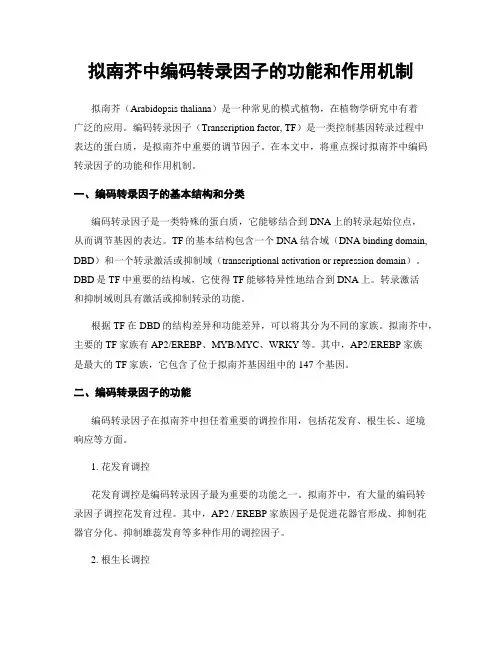
拟南芥中编码转录因子的功能和作用机制拟南芥(Arabidopsis thaliana)是一种常见的模式植物,在植物学研究中有着广泛的应用。
编码转录因子(Transcription factor, TF)是一类控制基因转录过程中表达的蛋白质,是拟南芥中重要的调节因子。
在本文中,将重点探讨拟南芥中编码转录因子的功能和作用机制。
一、编码转录因子的基本结构和分类编码转录因子是一类特殊的蛋白质,它能够结合到DNA上的转录起始位点,从而调节基因的表达。
TF的基本结构包含一个DNA结合域(DNA binding domain, DBD)和一个转录激活或抑制域(transcriptional activation or repression domain)。
DBD是TF中重要的结构域,它使得TF能够特异性地结合到DNA上。
转录激活和抑制域则具有激活或抑制转录的功能。
根据TF在DBD的结构差异和功能差异,可以将其分为不同的家族。
拟南芥中,主要的TF家族有AP2/EREBP、MYB/MYC、WRKY等。
其中,AP2/EREBP家族是最大的TF家族,它包含了位于拟南芥基因组中的147个基因。
二、编码转录因子的功能编码转录因子在拟南芥中担任着重要的调控作用,包括花发育、根生长、逆境响应等方面。
1. 花发育调控花发育调控是编码转录因子最为重要的功能之一。
拟南芥中,有大量的编码转录因子调控花发育过程。
其中,AP2 / EREBP家族因子是促进花器官形成、抑制花器官分化、抑制雄蕊发育等多种作用的调控因子。
2. 根生长调控编码转录因子也能够调节拟南芥中的根生长。
比如,MYB家族因子可以调节拟南芥的根毛形成,B1家族因子可以调节根的营养吸收等。
此外,WRKY等TF 家族也参与了拟南芥中根的发育调控。
3. 逆境响应调控拟南芥中,逆境响应是编码转录因子重要的调控方向。
逆境响应分为不同的类型,比如盐胁迫、干旱胁迫、草酸胁迫。
编码转录因子参与了各种不同类型的逆境响应调控。
MYB类转录因子在植物细胞生长发育中的作用及其应用刘忠丽;丛悦玺;苟维超;王响;陈坤明【摘要】The MYB family is one of the most important transcription factors family in plants. They play important roles in various processes including anthocyanin biosynthesis, environmental stress resistance, and the regulation of the growth and development of cotton fibers. Furthermore, these processes interact with each other with MYB as a key bridge. In this review,*we summarized and discussed these processes according to recent researches in MYB, mainly about the roles of MYB in the formation of anthocyanin, reaction to environmental stresses, and development of cotton fibers.%MYB是植物中重要的转录因子家族之一,它在调节花色素形成,抵抗逆境胁迫,调节棉花纤维发育等过程中发挥着重要的作用,且上述过程以MYB为中心,相互制约和影响.文章简要综述了人们近年来对于MYB在花色素形成、环境胁迫应答以及棉花纤维发育的过程中的作用.【期刊名称】《浙江农业学报》【年(卷),期】2012(024)001【总页数】6页(P174-179)【关键词】MYB类转录因子;花色素;干旱;棉花纤维【作者】刘忠丽;丛悦玺;苟维超;王响;陈坤明【作者单位】浙江大学农业与生物技术学院作物科学研究所,浙江杭州310058;浙江大学农业与生物技术学院作物科学研究所,浙江杭州310058;西北农林科技大学生命科学学院,陕西杨凌712100;西北农林科技大学生命科学学院,陕西杨凌712100;西北农林科技大学生命科学学院,陕西杨凌712100【正文语种】中文【中图分类】Q78MYB(myeloblastosis)家族转录因子是植物中重要的一类转录因子,在生物体内主要起转录激活作用。
NAC转录因子的研究进展作者:吴丹丹来源:《中国科技博览》2016年第28期[摘 ;要]NAC是植物特有的一类转录因子,其N端含有高度保守的NAC结构域,参与植物多个生长发育过程,还参与植物对逆境胁迫的响应。
本文对NAC转录因子加强植物对高盐、低温、干旱等非生物胁迫耐受力的最新研究进展进行综述。
[关键词]NAC转录因子 ;非生物胁迫综述中图分类号:TU857 文献标识码:A 文章编号:1009-914X(2016)28-0164-01转录因子(transcription factors,TF)又称反式作用因子,是一类能与真核基因启动子区域中的顺式作用元件发生特异性结合,从而保证目的基因以特定强度、在特定时间与空间表达的蛋白质分子。
植物在生长发育过程中,经常会受到各种非生物和生物的逆境胁迫如高温、低温、高盐、干旱、病原菌等的影响。
而这些逆境胁迫通常会对植物的细胞造成不同程度的损伤,从而更加进一步地对植物的生长发育和作物产量及品质造成严重影响。
在长期不断的进化过程中,植物形成了许多分子机制来应付生物和非生物胁迫,在特殊目标基因中通过调节激活或抑制转录因子的影响来适应外界的胁迫。
当植物感受外界干旱、高盐、激素、病害时,通过一系列信号传导,激发转录因子表达并与相应的顺式作用元件结合,启动特定基因的转录表达,最后通过基因产物的作用对内、外界信号作出的调节反应。
NAC是高等植物中所特有的一类转录因子,其命名来源于上世纪90年代发现的3个基因片段—矮牵牛NAM基因、拟南芥ATAI} /2和(}JC}基因。
1996年Soueretai报道的NAM ( No APica1 Meristan)是第一个分离到的NAC基因。
它能影响矮牵牛顶端分生组织的形成与分化。
研究发现nam突变体幼苗不能生成正常的茎尖分生组织,多数死亡,少数逃逸死亡的植株花器官发育异常。
1997年Aidaetal又在拟南芥中发现了能产生类似效应的CUC2 ( CuR shaped Cotvledon)。
植物转录因子研究方法及应用随着基因组测序技术的进步,越来越多的植物基因被发现,但是这些基因的功能和调控机制仍然是一个挑战。
转录因子(Transcription Factor, TF)是一类能够结合DNA序列并调控基因转录的蛋白质,是基因表达调控的关键因素。
因此,研究植物转录因子的结构、功能和调控机制,对于理解植物生长发育、逆境响应和代谢调控等方面具有重要意义。
本文将介绍当前常用的植物转录因子研究方法及其应用。
一、转录因子的鉴定转录因子的鉴定是转录因子研究的第一步。
常用的方法有两种:一是利用基因组学和生物信息学的方法预测植物基因组中的转录因子基因;二是利用转录组学的方法筛选差异表达的转录因子基因。
基因组学和生物信息学的方法主要是通过对植物基因组中的DNA序列进行分析,预测其中可能存在的转录因子基因。
例如,通过对Arabidopsis thaliana基因组进行分析,可以预测出1450个转录因子基因。
转录组学的方法则是通过对不同组织、不同生长阶段或不同环境下的植物进行转录组测序,筛选出差异表达的转录因子基因。
例如,利用RNA-seq技术对水稻叶片进行转录组测序,可以筛选出不同环境下的差异表达的转录因子基因。
二、转录因子的结构与功能转录因子的结构和功能是研究转录因子的关键。
转录因子的结构通常包括DNA结合结构域、转录激活结构域和其他结构域。
其中,DNA结合结构域是转录因子与DNA结合的关键结构域,通常包括基本区域(Basic region, bZip)和顺式作用元件结合区域(Helix-turn-helix, HTH)等。
转录激活结构域是转录因子与转录因子结合蛋白(Co-activator)结合的关键结构域,通常包括酵母活化区域(Activation domain, AD)和补体C1结构域等。
其他结构域包括核定位信号、核糖体结合蛋白结构域等。
转录因子的功能是通过结合DNA序列来调控基因转录。
转录因子可以结合基因启动子区域的顺式作用元件(Cis-acting element),激活或抑制基因转录。
2022,42(2):001J.SHANXI AGRIC,UNIV .(Natural Science Edition )学报(自然科学版)04091谷子mTERF 基因家族全基因组鉴定与分析任雪梅1,刘浩瑞1,南力彰2,陈晋杰1,韩渊怀1,2*(1.山西农业大学生命科学学院,山西太谷,030801;2.山西农业大学农学院,山西太谷,030801)摘要:[目的]线粒体转录终止因子(mitochondrial transcription termination factor ,mTERF )是由核基因编码调控细胞器基因表达的一类蛋白。
本研究从谷子基因组中鉴定了mTERF 基因家族成员,为探究该基因家族在谷子生长发育中的生物学功能提供理论基础。
[方法]通过生物信息学方法分析该家族基因的染色体分布、系统发育进化树、保守结构域及基序、顺式作用元件、基因表达及亚细胞定位。
[结果]共鉴定到37个谷子mTERF 基因家族成员,在染色体上呈不均匀分布,1号染色体上基因数目最多;37个谷子mTERF 蛋白都含有保守的mTERF 结构域,绝大多数mTERF 蛋白中motif 按一定的顺序排列,motif1在每个mTERF 蛋白上较其它motif 保守;该家族含有光、干旱诱导、醇溶蛋白代谢、细胞周期、昼夜节律、黄酮合成响应的顺式元件以及生长素、赤霉素等多种植物激素响应的顺式元件;谷子、玉米及拟南芥的97个mTERF 家族的基因可分为6大类;谷子mTERF 基因表达具有组织特异性,其中Si9g06960在叶片的表达量最高;该家族蛋白主要在叶绿体及线粒体中有定位信号。
[结论]谷子mTERF 基因家族可能影响叶绿体及线粒体的形态发育,对谷子的生长及逆境响应等生物学过程发挥着重要的作用,该研究有助于了解谷子mTERF 对谷子生长发育及抗逆等生物学过程的意义,为后续基因的研究提供指导。
关键词:谷子;mTERF ;全基因组;表达分析中图分类号:S515文献标识码:A文章编号:1671-8151(2022)02-0001-11谷子(Setaria italica )是我国古老的栽培粮食作物[1]。
三个拟南芥NAC同源基因突变体的ABA响应及下游基因表达分析摘要:在获得拟南芥NAC同源基因(NAC019、NAC055和/V AC072)双突变体和三突变体纯系的基础上,进一步分析它们对ABA响应的生理差异及其ABA诱导相关下游基因的表达变化,深入探讨它们与ABA响应的关系。
结果表明,在种子绿胚建成的过程中,NAC055和NAC072基因与ABA响应相关;在根生长方面,三者在ABA响应中作用不明显。
经ABA处理后,突变体nac072和nac055n,cac072与野生型比较,RAB18、RD29A和RD29B基因表达上调显著,推测在ABA响应的基因表达调控过程中,MC072和NAC055起负调控协同作用,而NAC019则发挥拮抗作用。
关键词:NAC;拟南芥;突变体;ABA响应文献标识码:ANAC(NAM,ATAF,CUC)转录因子是特异存在于植物中,具有多种生物功能的一类新型转录因子。
NAC转录因子的N端含有高度保守的NAC结构域,用于结合DNA,调节转录活性,C端是高度变异转录激活区[1]。
NAC转录因子具有诸多方面的功能,如参与植物次生生长、激素信号转导,以及在与生物胁迫和非生物逆境中发挥作用[2,3]。
从拟南芥中分离到3个不同的NAC基因NAC019、NAC055和NAC072,干旱诱导其表达,能与NACRE(NAC response elements)的核心元件CACC和MYC-Like元件CATCT的DNA体外结合[4]。
NAC072被报道参与ABA介导的逆境信号传导途径,超量表达显著增强转基因植株ABA敏感性,瞬时表达激活多CACC元件启动子活性[5]。
NAC019在ABA 信号传导中也起正向的调节作用[6];NAC019和NAC055在JA和ABA的信号转导途径之间存在交叉对话[7]。
拟南芥NAC072(RD26),NAC019和NAC055编码蛋白氨基酸序列同源性高,且其表达模式和遗传功能类似。
The Arabidopsis Transcription Factor MYB12Is a Flavonol-Specific Regulator ofPhenylpropanoid Biosynthesis1Frank Mehrtens2,Harald Kranz3,Pawel Bednarek,and Bernd Weisshaar*Max-Planck-Institute for Plant Breeding Research,D–50829Cologne,GermanyComprehensive functional data on plant R2R3-MYB transcription factors is still scarce compared to the manifold of their occurrence.Here,we identified the Arabidopsis(Arabidopsis thaliana)R2R3-MYB transcription factor MYB12as aflavonol-specific activator offlavonoid biosynthesis.Transient expression in Arabidopsis protoplasts revealed a high degree of functional similarity between MYB12and the structurally closely related factor P from maize(Zea mays).Both displayed similar target gene specificity,and both activated target gene promoters only in the presence of a functional MYB recognition element.The genes encoding theflavonoid biosynthesis enzymes chalcone synthase,chalconeflavanone isomerase,flavanone 3-hydroxylase,andflavonol synthase were identified as target genes.Hence,our observations further add to the general notion of a close relationship between structure and function of R2R3-MYB factors.High-performance liquid chromatography analyses of myb12mutant plants and MYB12overexpression plants demonstrate a tight linkage between the expression level of functional MYB12and theflavonol content of young seedlings.Quantitative real time reverse transcription-PCR using these mutant plants showed MYB12to be a transcriptional regulator of CHALCONE SYNTHASE and FLAVONOL SYNTHASE in planta,the gene products of which are indispensable for the biosynthesis offlavonols.Members of the MYB transcription factor superfam-ily are characterized by the presence of an amino acid motif structurally and functionally related to the DNA-binding domain of the product of the retroviral oncogene v-MYB and its animal cellular counterpart c-MYB.MYB proteins have been identified in a large number of eukaryotic organisms ranging from fungi (Stober-Gra¨sser et al.,1992;Ohi et al.,1994;Tice-Baldwin et al.,1989)to plants(for review,see Martin and Paz-Ares,1997;Jin and Martin,1999)and to vertebrates(Gonda et al.,1985;Slamon et al.,1986; Nomura et al.,1988).While the MYB domain of c-MYB consists of three imperfect repeats(referred to as R1, R2,and R3),proteins with other numbers of MYB repeats have also been identified(Kranz et al.,2000; Riechmann et al.,2000;Stracke et al.,2001;Jiang et al., 2004).In contrast to the situation in animals,R2R3-MYB genes in plants comprise a large gene family.In Arabidopsis(Arabidopsis thaliana),126MYB genes of the R2R3type have been described(Stracke et al.,2001; GenBank accession no.AF469468for At3g60460).For Oryza sativa(Jia et al.,2004)and maize(Zea mays;Rabinowicz et al.,1999),a minimum of80R2R3-MYB genes has been reported.Up to now,no or only few functional data are available for the overwhelming majority of plant MYB genes.The functional data available indicate that MYB transcription factors are involved in a wide array of cellular processes.These include development (e.g.AtMYB0/GL1[Oppenheimer et al.,1991;Esch et al.,1994;Shikazono et al.,1998],AtMYB66/WER[Lee and Schiefelbein,1999],and AtMYB103[Higginson et al.,2003]),signal transduction(e.g.AtMYB2[Urao et al.,1993]and AtMYB34/ATR1[Bender and Fink, 1998]),plant disease resistance(e.g.AtMYB30[Daniel et al.,1999]),cell division(e.g.AtCDC5,[Hirayama and Shinozaki,1996]),and secondary metabolism(e.g. AtMYB75/P AP1,AtMYB90/P AP2[Borevitz et al., 2000],AtMYB4[Jin et al.,2000],AtMYB123/TT2[Nesi et al.,2001;Baudry et al.,2004]and AtMYB61[Penfield et al.,2001]).The well-establishedflavonoid biosynthetic path-way(Fig.1)serves as a useful model for studying metabolic regulation.More than8,000differentflavo-noids have been identified in vascular plants(Pietta, 2000).This multitude of structures arises from a wide array of diverse modifications of the basicflavonoid scaffold,including methylations,acetylations,and glycosylations.Corresponding to the large variety of existingflavonoid compounds,their functions within the plant kingdom are diversified too,e.g.as pigments inflowers and fruit,as UV screens,as phytoalexins, or as regulators of auxin transport(for review,see Harborne and Williams,2000).The structural genes of the enzymes involved inflavonoid formation are pre-dominantly regulated at the level of transcription1This work was supported by the Max-Planck-Society,and in part by EC-BIOTECH(grant no.BIO4–CT95–0129to B.W.)and by the Deutsche Forschungsgemeinschaft.2Present address:Bielefeld University,Department of Biology, Genome Research,D–33594Bielefeld,Germany.3Present address:Gene Bridges GmbH,D–69120Heidelberg, Germany.*Corresponding author;e-mail bernd.weisshaar@uni-bielefeld. de;fax49–521–1066423.Article,publication date,and citation information can be found at /cgi/doi/10.1104/pp.104.058032.(for review,see Weisshaar and Jenkins,1998).The transcriptional regulation of the first enzyme in the flavonoid-specific part of phenylpropanoid biosynthe-sis,chalcone synthase (CHS),has been investigated in detail in Arabidopsis.Within an operationally defined minimal AtCHS promoter,three different cis-acting elements have been identified (Hartmann et al.,1998,2005).An ACGT containing element (ACE)and a MYB recognition element (MRE)comprise the light regula-tory unit (LRU AtCHS ),which confers responsiveness to UV-containing white light to the CHS promoter.The ACE and the MRE have been shown to be bound by basic region Leu zipper and MYB transcription factors,respectively (Armstrong et al.,1992;Feld-bru¨gge et al.,1997;Hartmann et al.,1998).A third cis-acting element has recently been identified between the ACE and the MRE in the CHS promoter.This element,designated R response element (RRE),is required forthe action of basic region helix-loop-helix (BHLH)-type transcription factors on the CHS promoter and might be involved in the regulation of the tissue-specific expression of CHS (Hartmann et al.,2005).Many R2R3-MYB proteins share an extended degree of sequence similarity,especially within the highly conserved MYB domain.However,it remains unclear if in general this apparent structural redundancy also accounts for functional similarity.For example,the structurally closely related proteins Zm C1/Pl (Cone et al.,1993)from maize,Ph MYBAN2from Petunia hybrida (Quattrocchio et al.,1993),and Am MYBROSEA from Antirrhinum majus (Schwinn et al.,2001)belong to a subfamily of R2R3-MYB proteins controlling an-thocyanin biosynthesis.Although the loss-of-function phenotype (reduction or loss of pigmentation)is the same in all these cases,the three factors display slightly different,though overlapping target gene specificities (Martin and Paz-Ares,1997),indicating no complete functional homology between these closely related MYB proteins.An example for the existence of true functional homology between closely related MYB proteins are the two Arabidopsis factors MYB66/WER and MYB0/GL1,which are involved in the regulation of trichome and root hair development,respectively.By reciprocal complementation experi-ments,it was shown that MYB66/WER and MYB0/GL1,although expressed in different tissues,encode functionally fully equivalent proteins.Hence,their unique roles in plant development are entirely due to differences in their expression patterns (Lee and Schiefelbein,2001).Because of the strong amino acid sequence similar-ity of the Arabidopsis R2R3-MYB factor MYB12to the maize MYB protein Zm P (84%identity within the MYB domain,67%overall similarity)that controls phloba-phene synthesis in floral organs (Styles and Ceska,1977;Grotewold et al.,1994;Chopra et al.,1996),we selected MYB12to investigate its role as a part of the regulatory network controlling phenylpropanoid metabolism in Arabidopsis.We studied MYB12func-tion by transient coexpression using protoplasts of cultured Arabidopsis cells.Knockout mutants and ectopic overexpression plants were generated and investigated with respect to a flavonoid phenotype.MYB12was found to be a flavonol-specific activator of flavonoid biosynthesis with the two flavonoid bio-synthesis genes CHS and FLS (flavonol synthase)as its primary targets.Transcriptional activation by MYB12is coactivator-independent but requires the presence of functional MREs within target promoters.RESULTSCotransfection Analyses Reveal MYB12and Zm P As Flavonol-Specific Activators of Flavonoid Biosynthesis in the At7Cell Culture SystemTo investigate if the structural similarity of MYB12and Zm P equivalents functional similarity of thetwoFigure 1.Simplified,schematic representation of the biosynthesis of flavonols and anthocyanidins.Abbreviations of the enzyme designa-tions are CHS,chalcone synthase;CHI,chalcone flavanone isomerase;F3H,flavanone 3-hydroxylase;FLS,flavonol synthase;F3#H,flavonoid 3#-hydroxylase;DFR,dihydroflavonol 4-reductase.Note that for the biosynthesis of flavonols the action of FLS is required while for the formation of anthocyanins DFR is necessary.Mehrtens et al.factors,a transient expression system using proto-plasts of cultured At7cells was utilized.In this system, the cotransfection of effector and reporter plasmid constructs(Fig.2)allows the quantification of pro-moter activity as well as the determination of the transactivation potential of a transcription factor by measuring uid A(b-glucuronidase[GUS])reporter activity.Figure3A summarizes transfection experiments carried out to compare the transactivation capacities of MYB12and Zm P within theflavonoid biosynthetic pathway(see Fig.1).The promoters of theflavonoid biosynthesis genes CHS,CHI(chalconeflavanone isomerase),F3H(flavanone3-hydroxylase),FLS, F3#H(flavonoid3#-hydroxylase),and DFR were tested as potential targets for MYB12and Zm P.MYB12 strongly activated the promoters of CHS,F3H,FLS, and,to some lesser extent,the CHI promoter.A similar activation pattern is displayed by Zm P,although the overall relative induction of promoter activity is gen-erally lower than for MYB12;notably,FLS induction reached only18%of that observed for MYB12.Neither MYB12nor Zm P were able to activate the F3#H or DFR promoters to a significant extent.A combination of two factors from maize,the R2R3-MYB factor Zm C1 and the BHLH factor Zm Sn,served as positive control for the functionality of the DFR promoter construct that was strongly activated by the combination of Zm C1/Zm Sn.The factor Zm Sn,when used in a control experiment as a single effector,showed marginal activation potential for the DFR promoter but no activation of the other promoters(Fig.3A).MYB12 and Zm P did,in contrast to Zm C1,activate the target promoters independently of the presence of the BHLH factor Zm Sn.In summary,the transactivation proper-ties of MYB12and Zm P in the transient expression system were almost identical with the exception of quantitative differences in the responsiveness of the FLS promoter to these two R2R3-MYB factors.MYB12Requires a Functional MYB Recognition Element for TransactivationTo identify functional cis-acting elements required for MYB12action,we assayed CHS promoter variants containing block mutations in the MRE,ACE,or the RRE(Fig.3B).A functional MRE was shown to be required for activation by MYB12.Again,Zm P be-haves similarly to MYB12,while the RRE was not necessary.By using Zm C1and Zm Sn in a control experiment,the functionality of the RRE was con-firmed.Mutation of the ACE of the LRU AtCHS did not interfere with action of the R2R3-MYB factors tested.Isolation of a myb12-ko Line and Generation of aMYB12-OX LineThe isolation of a myb12::En-1line(designated AT123,Columbia[Col-0]background)from the En/ Spm mutagenized AMAZE2population allowedthe Figure2.Schematic representations of the effec-tor and reporter constructs used for transient expression analyses.Effector constructs contain the cauliflower mosaic virus35S promoter fused to the respective effector ORFs followed by the nopaline synthase terminator(nosT).Reporter constructs contain the respective target promot-ers fused to the uidA-ORF followed by nosT.The length of the individual promoter fragments used is indicated.The three mutated variants of the CHS minimal promoter are named according to the mutated cis-element,respectively.R2R3-MYB Transcription Factor FunctionFigure 3.Cotransfection analysis of target gene specificities and cis-element requirements in At7protoplasts.A,Cotransfection assays to determine the activation of the promoters of flavonoid biosynthesis genes by MYB12,Zm P ,Zm Sn,and the combination of Zm C1/Zm Sn.The mean value of luciferase activities was 6,800RLU m g 21s 21.Samples were incubated for 20h in the dark at 26°C prior to harvesting.B,Identification of cis-elements required for the activation of the CHS minimal promoter by MYB12,Zm P ,and Zm C11Zm Sn.The mean value of luciferase activities was 7,600RLU m g 21s 21.Samples were incubated for 8h in the dark at 26°C prior to harvesting.A and B,The reporter/effector combinations used are indicated.Columns represent the relative GUS #activity in cotransfection experiments using discrete reporter/effector combinations.The highest occurring GUS #activity measured for each individual reporter construct was set to 100%.Each column represents the mean of six independent measurements.Error bars illustrate the SD of mean values.The data tables below the graphs give the respective absolute GUS #activity values measured.n.d.,Not determined.Mehrtens et al.in planta analysis of MYB12function and the valida-tion of the activity of MYB12in regulatingflavonoid biosynthesis.Figure4A depicts the genomic structure of the wild-type MYB12gene and of the myb12::En-1 allele.The presence of approximately12En-1elements in this line(data not shown)rendered it genetically unstable,impeding functional analyses.Repeated backcrossing to wild-type plants(accession Col-0) led to the isolation of an En-1-free,homozygous myb12-ko line carrying the myb12-1f footprint allele that is derived from myb12::En-1by excision of the En-1transposon.The myb12-1f allele has a single base pair deleted at the original insertion site(Fig.4B), which causes a frameshift that results in a premature termination of translation.The myb12-1f-encoded pro-tein lacks111C-terminal amino acids of the wild-type MYB12protein.The myb12-ko line was complemented with a4.5-kb genomic fragment containing the MYB12 coding region under the control of the native MYB12 promoter.The resulting transgenic line was desig-nated MYB12-COMP.In addition to the loss-of-function myb12-ko line,a homozygous35S-MYB12 ectopic overexpression line(MYB12-OX)was construc-ted.The plants of both the myb12-ko and the MYB12-OX line showed no obvious phenotypic changes when compared to wild type under greenhouse conditions.The myb12-1f Derived Protein Is Not Functional in Cotransfection AssaysTo address the question if the myb12-1f allele is still functional in activating the MYB12target promoters identified above,we used the myb12-1f allele to gen-erate an effector plasmid for cotransfection analyses. Figure5summarizes the results of the corresponding cotransfection experiments,illustrating that neither of the tested promoters showed any response to the myb12-1f protein.Thus,the truncated protein seems to be devoid of any activation potential indicating that the myb12-1f allele is not functional.MYB12-OX and myb12-ko Plants Display a Flavonol Accumulation PhenotypePlants of the myb12-ko and MYB12-OX lines were analyzed for theirflavonol contents by HPLC.Pilot experiments showed that young myb12-ko seedlings contained reduced amounts offlavonoids,while seed-lings as well as leaves of MYB12-OX plants displayed an increasedflavonoid content.For the following analyses,we concentrated on a series of2-to6-d-old developing seedlings grown under continuous white light that were sampled at1-d intervals.In wild-type seedlings,five different quercetin and three different kaempferol derivatives were detected that originate from different glycosylation patterns of the aglycone (Fig.6A).Under the growth conditions used,all plants contained higher amounts of total quercetin than total kaempferol.For Col-0wild-type seedlings,the average ratio between quercetins and kaempferols was about 1.5.At all time points both the quercetin and the kaempferol content of myb12-ko seedlings was clearly reduced compared to the wild-type reference.For MYB12-OX seedlings,the opposite effect was ob-served;quercetin and kaempferol content were signif-icantly increased(Fig.6B).To check whether the biochemical alterations also extend to anthocyanidins, the anthocyanidin content of6-d-old seedlings of wild-type,myb12-ko,and MYB12-OX seedlings was deter-mined.No significant differences in anthocyanin con-tent were detected(Fig.6C),indicating that MYB12 does not control anthocyanin accumulation.Taken Figure4.Genomic structure of myb12al-leles.A,Schematic overview and partial structure of the third exon of the originally isolated myb12::En-1line(AT123).White boxes symbolize exons and the connecting lines introns.Numerical values above exons indicate nucleotide positions relative to the transcription start site.Intron lengths are in-dicated.The En-1transposon insertion took place between nucleotides at positions869 and870.The nucleotides of the3-bp target sequence duplication of the En-1transposon are highlighted by underscore.The arrow upside the transposon marks its orientation. B,Comparison of nucleotide and protein se-quence of wild-type(MYB12)and myb12-1f alleles.Only the third exon is shown.In the genetically stable myb12-1f line the deletion of the guanidine nucleotide at position869 leads to the premature termination of trans-lation.The myb12-1f protein comprises only 260amino acids compared to370in the wild-type case.In addition the sequence of the last seven amino acids is altered at six positions.R2R3-MYB Transcription Factor Functiontogether,a clear and specific correlation between MYB12activity and the flavonol content in developing seedlings was observed.MYB12-COMP Plants Show Normal Flavonol AccumulationSuccessful complementation of the myb12-ko line was demonstrated by HPLC analysis of 6-d-old MYB12-COMP seedlings.As shown in Figure 6D,relative quercetin and kaempferol amounts in MYB12-COMP and wild-type plants were very similar.Both quercetin and kaempferol levels in the MYB12-COMP line reached about 90%of wild-type levels.The Expression Levels of Biosynthetic Genes in the Flavonoid Biosynthetic Pathway Is Affected by MYB12To analyze the effect of MYB12on the expression of flavonol biosynthesis genes in planta,quantitative realtime reverse transcription (RT)-PCR analyses were carried out using double labeled fluorogenic hybrid-ization probes (TaqMan probes).The PCR efficiencies of all TaqMan systems,i.e.primer and probe combi-nations,proved to be identical within the boundaries of the error of measurement;efficiency values reached 100%(Fig.7A).Figure 7B depicts the results of the quantitative RT-PCR analyses.The MYB12expression level in wild-type seedlings showed only little varia-tion over the course of the kinetic,reaching a maxi-mum at day four or five.The values for myb12-ko seedlings were virtually identical,which is explained by the fact that the chosen TaqMan probe for MYB12was not able to differentiate between transcripts from the MYB12wild type and the myb12-1f allele.MYB12was strongly (over)expressed in MYB12-OX seedlings with relative expression levels ranging from 50-to 80-fold above that of 2-d-old wild-type seedlings.The biosynthesis genes of the flavonoid pathway canbeFigure 5.The myb12-1f allele is not functional.The reporter/effector combinations used are indicated.Columns represent the relative GUS #activity in cotransfection experiments using discrete reporter/effector combinations.The highest occurring GUS #activity measured for each reporter construct was set to 100%.Each column represents the mean of six independent measurements.Error bars illustrate the SD of mean values.The data table below the graph gives the respective absolute GUS #activity values measured.The mean value of luciferase activities was 4,500RLU m g 21s 21.Samples were incubated for 8h in the dark at 26°C prior to harvesting.Mehrtens et al.Figure 6.Biochemical myb12-ko phenotype.A,Representation of a selected HPLC result.The example shows the chromato-gram obtained from a methanolic extract of 2-d-old wild-type seedlings.Peaks identified as corresponding to quercetin or kaempferol derivatives and the internal standard naringenin are labeled.Retention times are indicated above the peaks.K,Kaempferol;N,naringenin;Q,quercetin.B,Relative quantification of flavonols (total quercetins and total kaempferols)in methanolic extracts of developing Arabidopsis seedlings by HPLC analysis.The age and the genotype of the seedlings (WT,wild type)analyzed are indicated.Naringenin was used as an internal standard (relative amount arbitrarily set as one).Error bars indicate the SD of the average of relative quercetin/kaempferol amounts determined as triplicates in two independent biological replicates.C,Photometric determination of anthocyanin content in methanolic extracts of 6-d-old Arabidopsis seedlings.A 530,Absorption at 530nm;A 657,absorption at 657nm.Error bars represent the SD of the average from a total of six measurements using two independent biological replicates.D,Complementation of the myb12-ko phenotype by transformation of myb12-ko plants with a 4.5-kb MYB12genomic fragment.Relative flavonol contents in methanolic extracts of 6-d-old wild-type,myb12-ko,MYB12-COMP ,and MYB12-OX plants were determined by HPLC.R2R3-MYB Transcription Factor Functiongrouped into four categories in terms of their respon-siveness to MYB12;the expression of the members of the first category,CHS and FLS ,showed a clear corre-lation to the MYB12expression level.In myb12-ko seedlings,the expression of both genes was reduced,while overexpression of MYB12resulted in increased expression of both genes.CHI and F3H constitute the second category.No effect of the lack of MYB12activity (myb12-1f plants)was observed for CHI andF3H .However,the expression level of both genes was in general increased in response to elevated MYB12expression.The effect was more pronounced for CHI (5-to 17-fold increase)than for F3H (2-to 5-fold increase).The third category solely consists of the F3#H gene whose expression was more or less un-affected by changes in MYB12expression.The differ-ences in F3#H expression were always less than 2-fold and not consistent in the myb12-ko and MYB12-OXFigure 7.CHS and FLS are primary target genes of MYB12.A,Determina-tion of PCR efficiencies in quantitative real time PCR.The example shows the determination for MYB12as PCR tar-get.The plot of the natural logarithm of template concentration against the threshold cycle number results in a lin-ear standard curve.The efficiency of the PCR system used can be calculated from the slope of the graph.The equa-tion and the corresponding correlation coefficient of the linear regression line is shown.The calculated efficiency value is also indicated.For details of the method see ‘‘Materials and Meth-ods.’’E,PCR efficiency;ln,natural logarithm;R 2,correlation coefficient of linear regression line.B,Results of quantitative real time RT-PCR analyses of RNA from developing Arabidopsis seedlings.Columns represent the rela-tive expression levels of the distinct target genes tested.The mRNA amount in 2-d-old wild-type (WT)seedlings served as a calibrator for the calcula-tion of relative expression levels in all cases (relative expression arbitrarily set to one).Relative expression was de-termined in triplicate measurements in two independent biological replicates.The age and the genotype of the seed-lings analyzed are indicated.Mehrtens et al.plants,although a slight trend of increased expression is observed in some of the MYB12-OX samples.The single member of the fourth category is the DFR gene whose expression under the experimental conditions chosen was extremely low in all samples analyzed.In general,the expression values of DFR relative to the CHS calibrator were below0.05(data not shown). Taken together,the data from quantitative real time RT-PCR analyses showed that only the two genes of thefirst category,CHS and FLS,were fully MYB12 responsive.No myb12-1f effect was detected on the otherflavonoid genes analyzed(CHI,DFR,F3H,and F3#H).However,CHI and F3H displayed elevated expression levels in response to increased MYB12 expression.DISCUSSIONMYB12and Zm P Share FundamentalFunctional CharacteristicsCotransfection analyses revealed substantial func-tional similarities between the plant R2R3-MYB tran-scription factors At MYB12and Zm P.MYB12acts via a MRE(Feldbru¨gge et al.,1997)and independently of a BHLH coactivator,similar to Zm P that was shown tobind the MREs in severalflavonoid biosynthesis genes (Hartmann et al.,2005).Both factors show identical activation patterns in our test system by activating the CHS,CHI,F3H,and FLS promoters;all these genes are required forflavonol biosynthesis.AtF3#H and AtDFR are neither activated by MYB12nor by Zm P(summa-rized in Fig.8).In maize,the C2(5CHS),CHI,and A1 (5DFR)genes that are required for the formation of 3-deoxy-flavonoids and phlobaphenes are regulated by Zm P(Grotewold et al.,1994).Although not for-mally proven,Zm P is probably no activator of ZmF3H, otherwise its activity would lead to the formation of anthocyanins rather than phlobaphenes in maize ker-nels.This difference,i.e.the responsiveness of AtF3H but not AtDFR to MYB12in contrast to the respon-siveness of ZmDFR but not ZmF3H to Zm P,probably reflects the divergent evolution of the promoter se-quences of these two genes,constituting the basis for the observed metabolic difference between maize and Arabidopsis.A similar differential regulation has also been described for the CHS promoter between maize and P.hybrida(Quattrocchio et al.,1998).Recent studies of the protein-protein interaction specificities of the R2R3-MYB protein family revealed specific conserved amino acid signatures to be the struc-tural basis for interaction of R2R3-MYB and R/B-like BHLH proteins(Grotewold et al.,2000;Hernandez et al.,2004;Zimmermann et al.,2004).None of the identified amino acid motifs was found to be present in the MYB12or Zm P amino acid sequences.More-over,yeast-two-hybrid experiments showed no inter-action between MYB12or Zm P and R/B-like BHLH transcription factors(Zimmermann et al.,2004).Also,the results of transfection assays using mutated ver-sions of the CHS minimal promoter(Fig.3B)support the view of MYB12as a cofactor-independent activa-tor,again similar to Zm P.Taken together,our results suggest that AtMYB12is the functional homolog of P from maize.However,we cannot exclude that Zm P might have additional regulatory functions beyond controlling phlobaphene accumulation.In contrast to MYB12and Zm P,Zm C1showed a different behavior.As described before,Zm C1regu-lates together with a R/B-like BHLH partner(e.g. Zm Sn)anthocyanin biosynthesis in maize kernels (Mol et al.,1996,1998;Procissi et al.,1997).In addition to the previously reported activation of the AtCHS promoter by the combination of Zm C1/Zm Sn (Hartmann et al.,2005),we show that also the promot-ers of CHI,F3H,and DFR are activated by Zm C1plus Zm Sn.Zm Sn alone is not able to activate reporter expression in cotransfection experiments.The excep-tion is the weak activation of the DFR promoter that might be caused by either Sn alone or by an endogenous Zm Sn-interacting factor(potentially a R2R3-MYB)pre-sent in the protoplasts.The FLS gene,which encodes the enzymeflavonol synthase that catalyzes the committing step toward flavonols,is not responsive to Zm C1plus Zm Sn but is, as mentioned above,fully responsive to MYB12.This result again supports the notion of differential control offlavonol and anthocyanin biosynthesis by pathway-specific transcription factors also in Arabidopsis.The principle mode of regulation of anthocyanin and tannin accumulation via the combinatorial actionof Figure8.Overview of MYB12effects onflavonoid gene expression. The top of thefigure shows a schematic representation of the enzymatic steps offlavonoid biosynthesis.The table below summarizes the results of the quantitative real time RT-PCR of mutant plants and the cotransfection analyses performed.‘‘1’’indicates weak,‘‘11’’me-dium,and‘‘111’’strong gene expression or activation of reporter gene transcription,respectively;‘‘2’’indicates no effect on target gene expression or on activation of reporter gene transcription,‘‘---’’indicates strong reduction in target gene expression.R2R3-MYB Transcription Factor Function。